Introduction
EK CoolStream CE 140 Radiator Review
Welcome to another Extreme Rigs radiator review. Today we’ll be looking at the CoolStream CE 140 from EKWB. Released in July this year, the CE series encompasses all of EK’s radiators suitable for use with 140mm size fans. The CE 140 we’ll be looking at in this review is the single fan version and will be the last of this size radiator to be checked out this year. We’ll find out what makes the CE 140 tick, analyze it’s performance data and compare it’s results against the other 140mm radiators we have tested.
Previously we reviewed the CE 420 and currently the CE 280 is under scrutiny, so this CE 140 review will form part of the “CE Roundup”.
Firstly a big thanks to EKWB for providing the review sample of the CE 140. The support offered by EK has been exemplary over the past 18 months since our radiator testing commenced and it really is greatly appreciated. Thanks guys!
Before we start we would like to say thanks to Noctua for providing the NF-A14 Industrial PPC-2000 IP67 PWM 140mm fans. We use these fans for all our 140mm based radiator thermal performance testing.
What’s in the Box?
The CE 140 sample arrived in full retail packaging featuring EK’s lime green color code used for their radiators and fans.
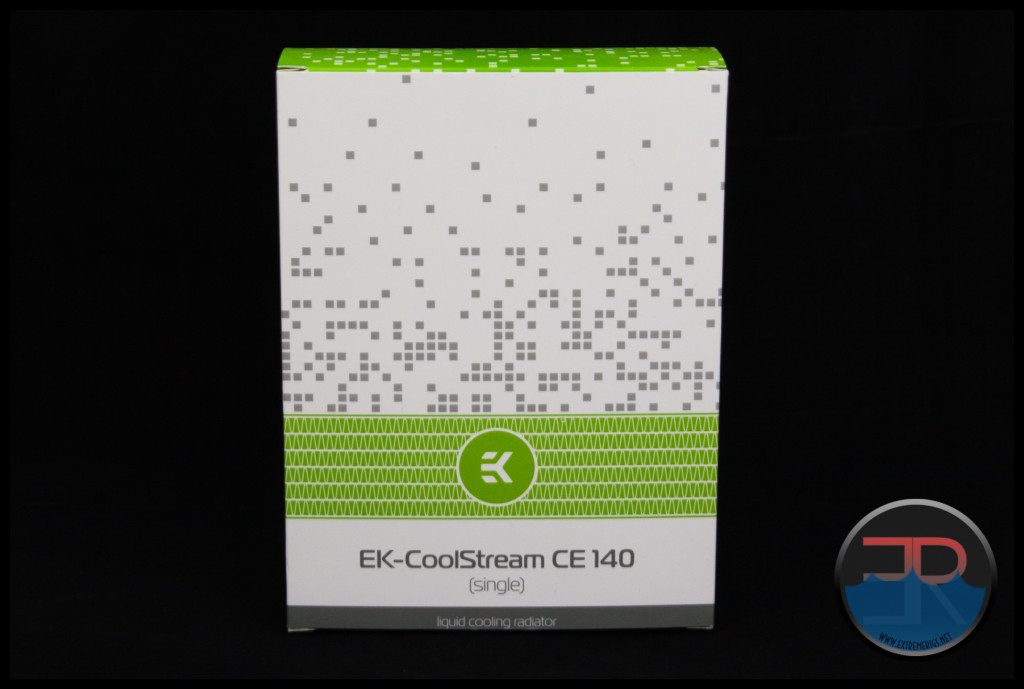 The graphics are plain and simple, but I do like the band of radiator fins.
The graphics are plain and simple, but I do like the band of radiator fins.
On the back, some key points and technical details are listed.
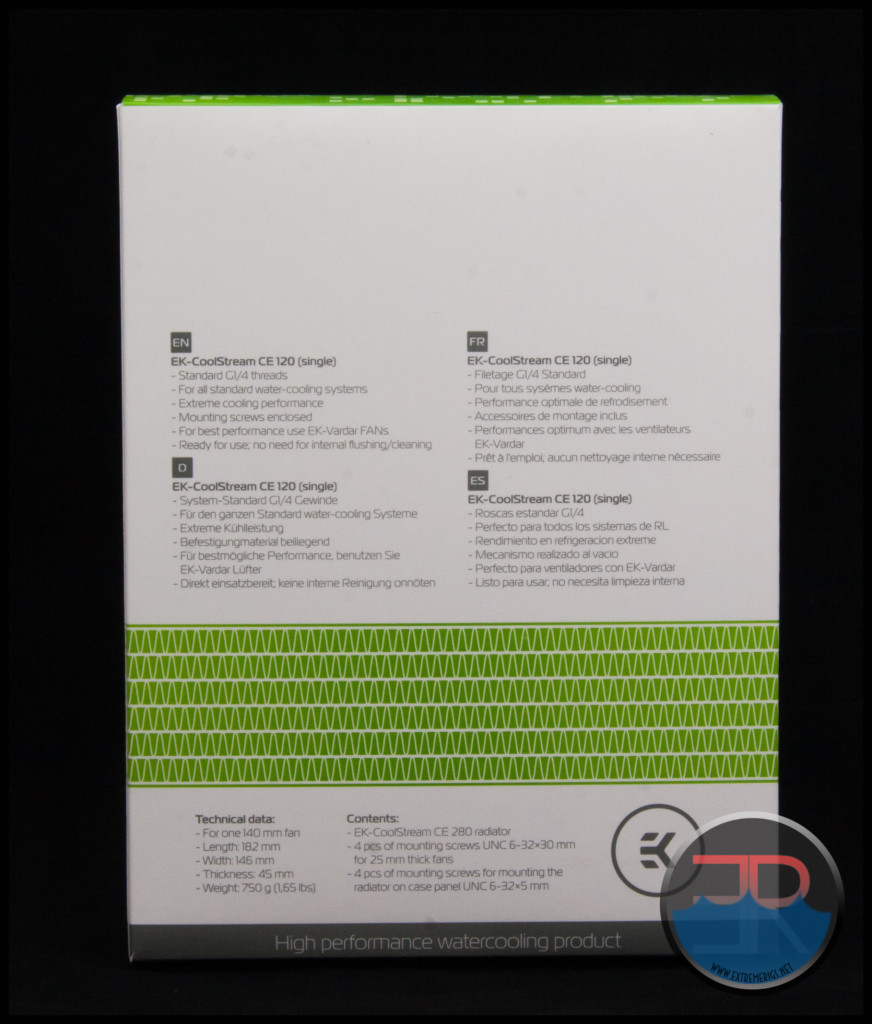 Seems as though a few typos were made with the model number, as “120” mm is not part of the CE series and we clearly have a 140mm radiator for review, not a 280 as per the listed contents.
Seems as though a few typos were made with the model number, as “120” mm is not part of the CE series and we clearly have a 140mm radiator for review, not a 280 as per the listed contents.
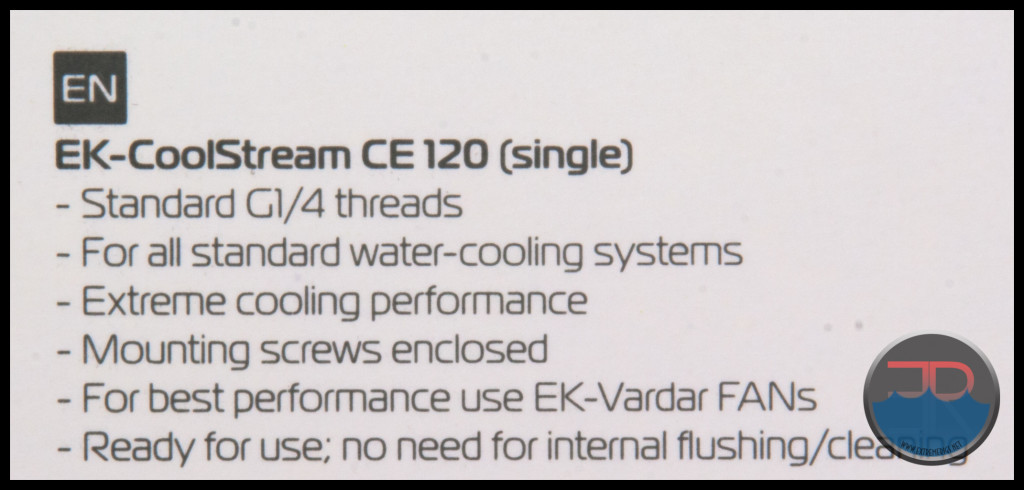 Our feelings about the “Ready for use” key point are well known to regular readers by now. Suffice to say that we encourage end users to always flush new radiators prior to installing into their system.
Our feelings about the “Ready for use” key point are well known to regular readers by now. Suffice to say that we encourage end users to always flush new radiators prior to installing into their system.
Removing the outer sleeve we find a sturdy shipping box.
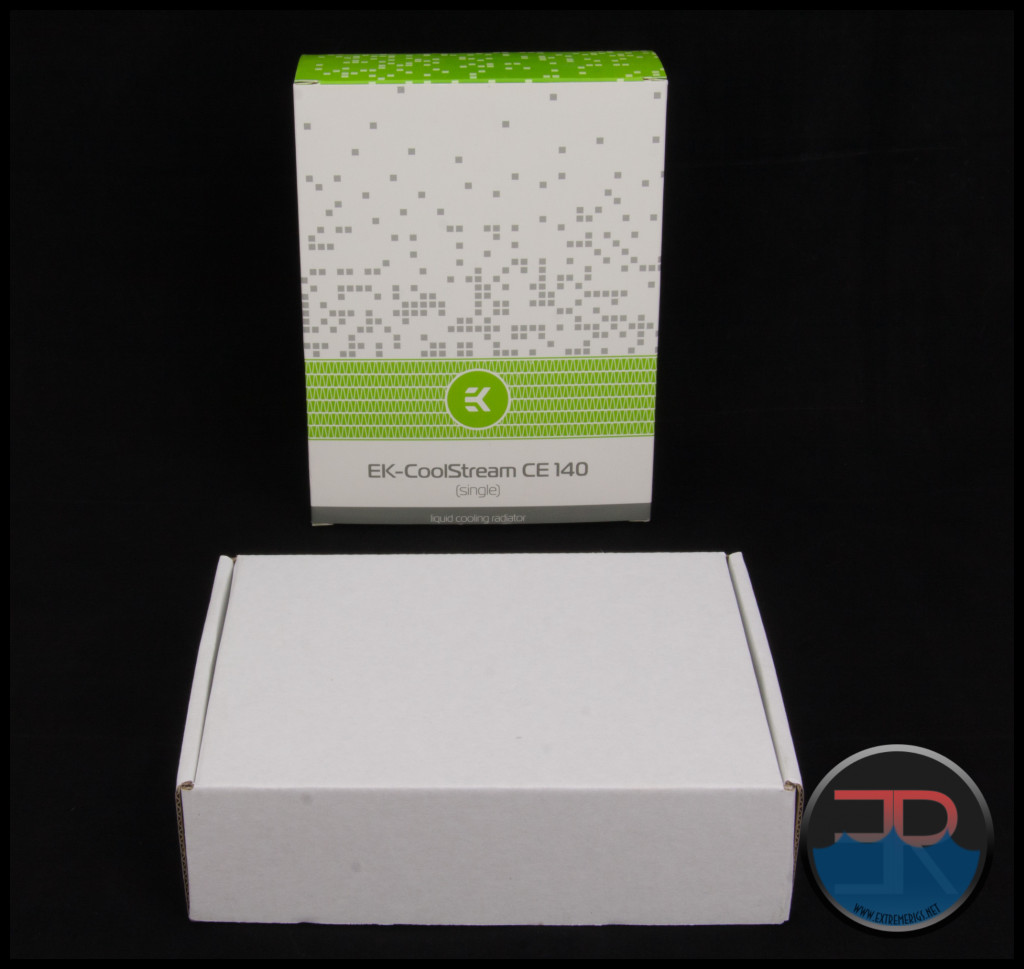
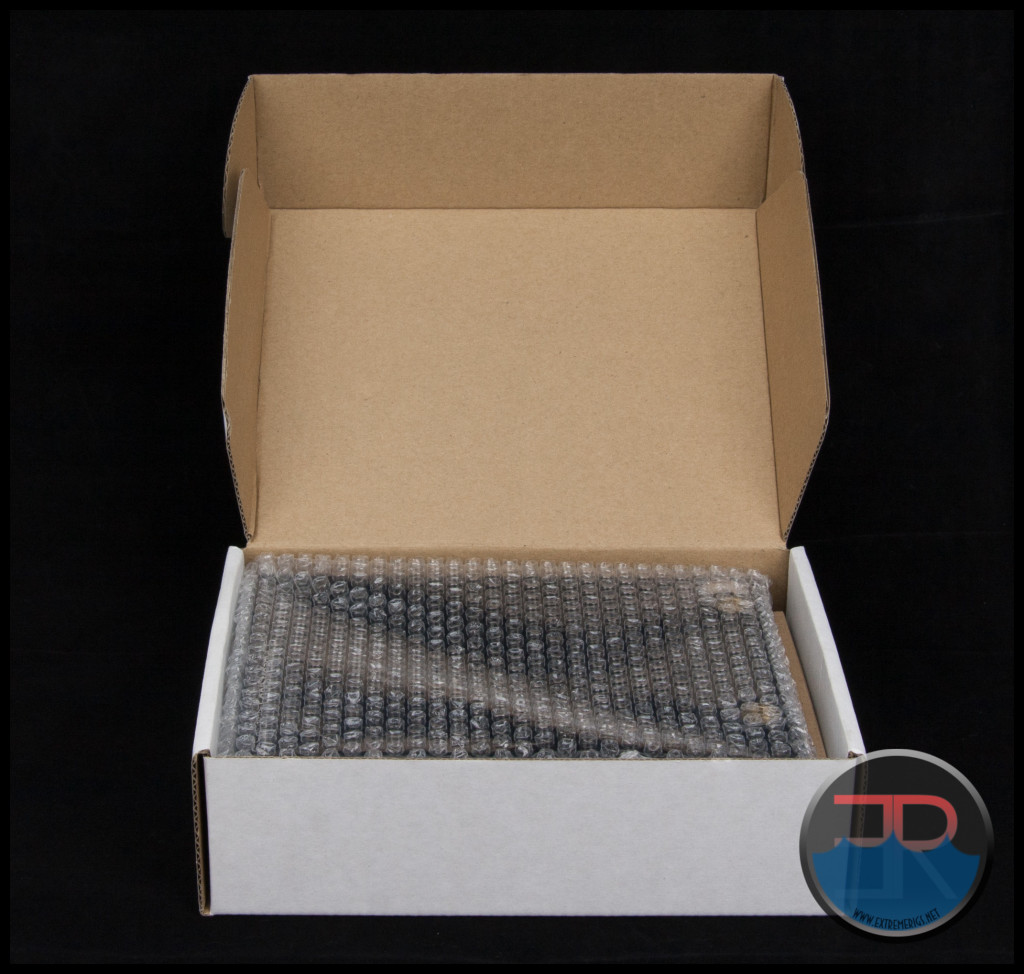 The radiator has a bubble wrap sleeve which offers addition protection during shipping. The EK radiator packaging is about as good as one could hope for.
The radiator has a bubble wrap sleeve which offers addition protection during shipping. The EK radiator packaging is about as good as one could hope for.
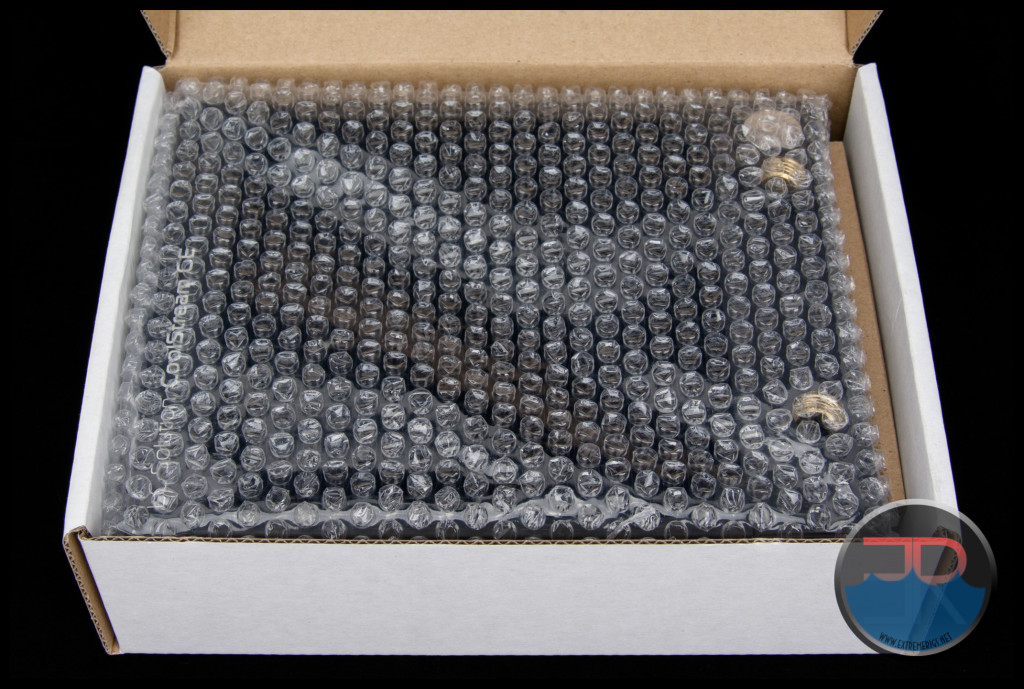 The accessories are in a piece of taped up cardboard tucked safely at one end of the box. This prevents the accessories becoming loose during transport and helps keep the fragile core from sustaining any damage. Simple yet effective.
The accessories are in a piece of taped up cardboard tucked safely at one end of the box. This prevents the accessories becoming loose during transport and helps keep the fragile core from sustaining any damage. Simple yet effective.
Extent of delivery as listed by EK:
Enclosed:
– EK-CoolStream CE series radiator /w two pre-installed G1/4 extenders
– Flat-head UNC 6-32 screws (l=30mm)
– Flat-head UNC 6-32 screws (l=5mm)
– Allen key 2,5mm
– Allen key 9mm
The above contents list is what is currently on the EK website, however the packaging makes no mention of the 9mm Allen Key. The review sample was not supplied with the 9mm allen key which is used for loosening or tightening the port extenders as we will see later.
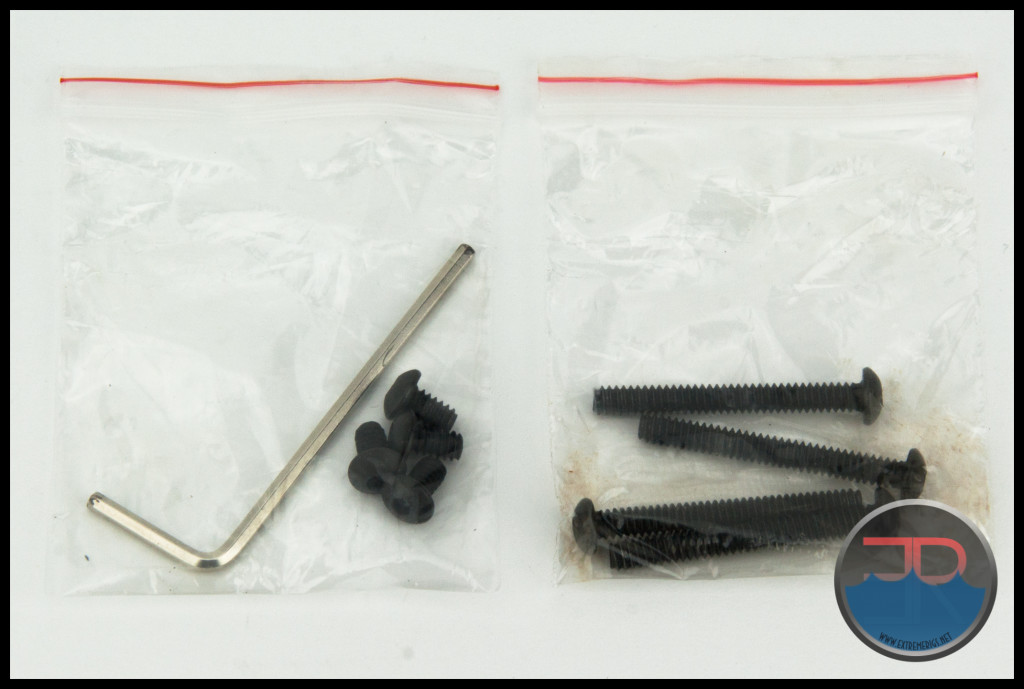 The following caution note is from the EK website, but was not found anywhere on or in the packaging.
The following caution note is from the EK website, but was not found anywhere on or in the packaging.
 So we have been warned, choose screw lengths carefully, particularly if using a mounting bracket or vibration reducing gaskets and remember to make compensation for the amount of compression when tightening down if foam gaskets are fitted.
So we have been warned, choose screw lengths carefully, particularly if using a mounting bracket or vibration reducing gaskets and remember to make compensation for the amount of compression when tightening down if foam gaskets are fitted.
Onwards to technical specifications!
Technical Specifications
Technical specifications: as listed by EK.
Technical details:
Material:
– Copper fins
– 90% copper tubing (H90)
– Brass chambers
– Aluminum/Steel housing
Dimensions: 180 x 145 x 45mm (L x W x H)
Weight: 0.75kg
Liquid Capacity: ~200mL
FPI: 16
Port threads: 2x G1/4
Fan compatibility: any standard size 140x140x25mm fan; UNC 6-32 thread tapping
Pressure tested: 1bar(g)
The following technical drawings of the CE 140 are courtesy of EKWB.
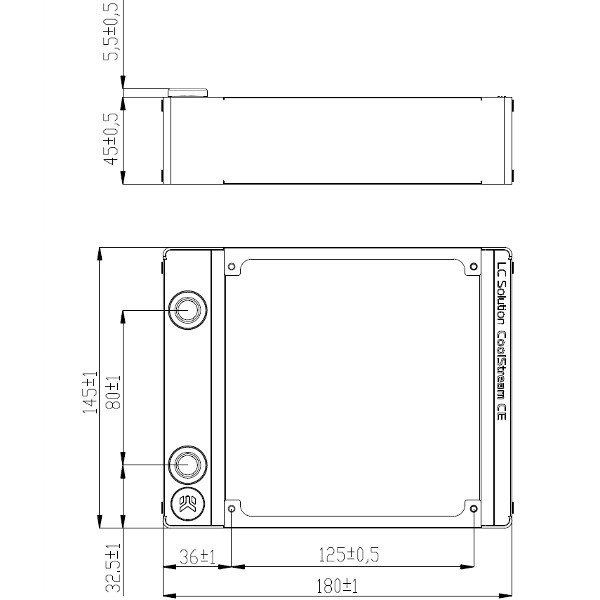
Note the top image has the extra 5.5mm (+/- .05) section which is the amount the port extenders sit proud of the casing. On the review sample this measured 5.3mm.
Dimensions Measured on the Radiator Tested:
 The core is made up of 2 rows of 15 tubes arranged in the standard U-Flow configuration. The fin arrangement consists of single, non louvered fins with a 16 FPI count. This medium thickness, medium density core will likely prove to be a combination capable of good performance with medium speed fans.
The core is made up of 2 rows of 15 tubes arranged in the standard U-Flow configuration. The fin arrangement consists of single, non louvered fins with a 16 FPI count. This medium thickness, medium density core will likely prove to be a combination capable of good performance with medium speed fans.
The following picture is a reference which shows a typical U-Flow coolant flow path, where the coolant travels up all the tubes on one side (left in pic) of the rad and then returns down the other side. U-Flow is most easily recognized when the port end has 2 separate tanks, unlike the CE 140 which the tanks fully enclosed in the external casing.
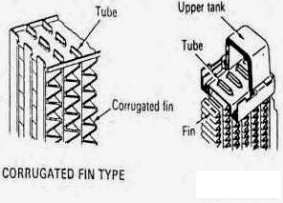
The single non louvered fins are spaced rather unevenly between the tubes and our sample had a fin count spread of 14 FPI to 18 FPI.
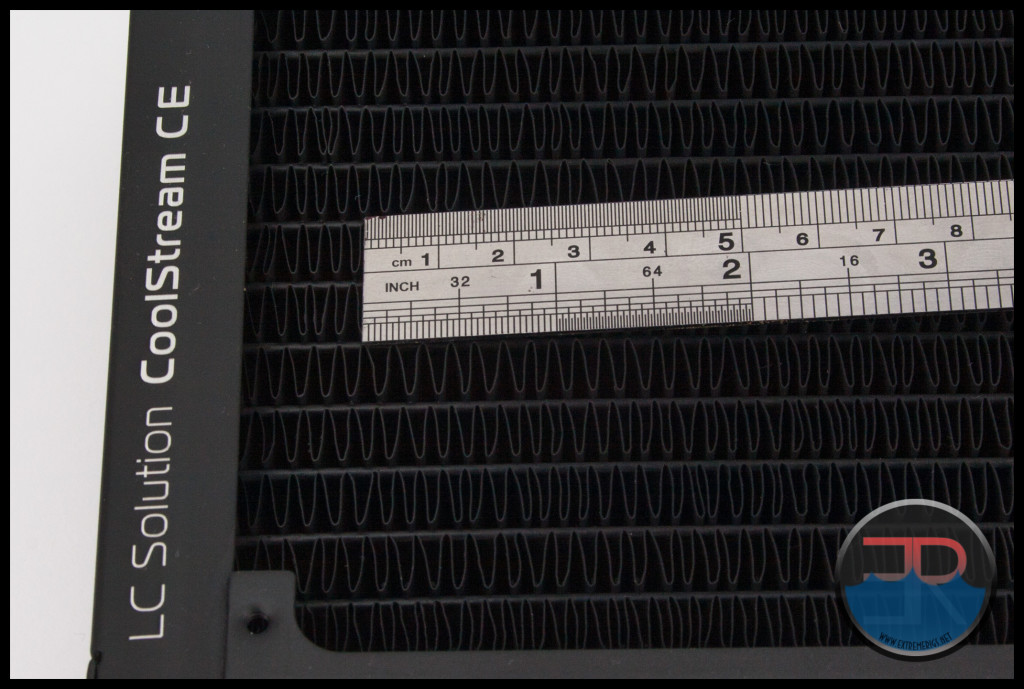
Previously I mentioned the fins being non louvered, this is true for all the fins except the outside row on each side which are louvered for some reason and have a much lower fin count.
Finish and Features
The CE 140 has a satin black finish which looks great and is smooth to touch. Close inspection shows the finish is actually quite bumpy. The black is not quite black either, but more of a deep charcoal grey. In any case the finish looks great but does tend to scuff up rather easily.
At the non-port end is the seemingly mandatory branding we find on almost all of our gear. At least it’s tastefully done, but we can’t help thinking that it will be upside down in most vertical installations, where having the ports at the top is usually preferred to assist in bleeding air from the system.
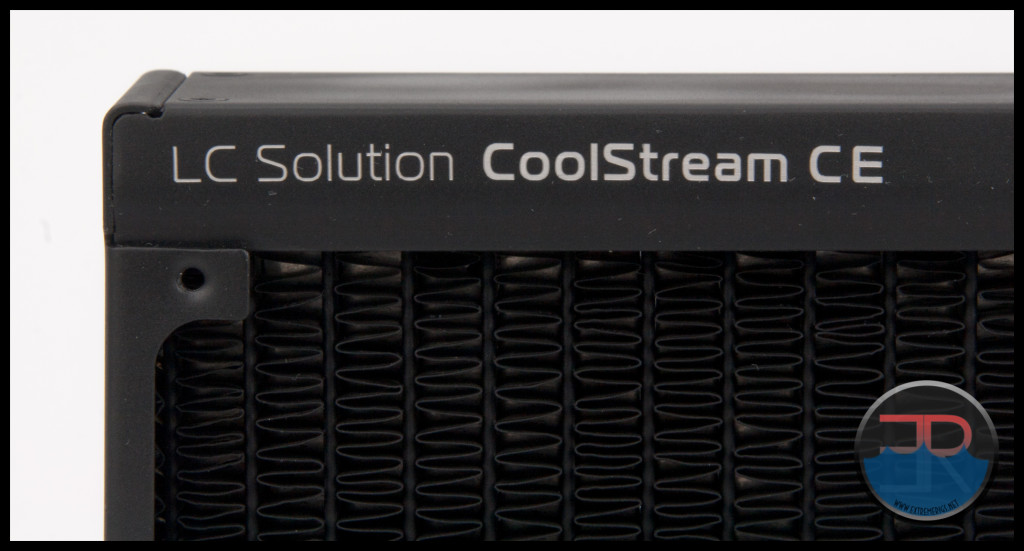
Screw protection plates are not fitted.
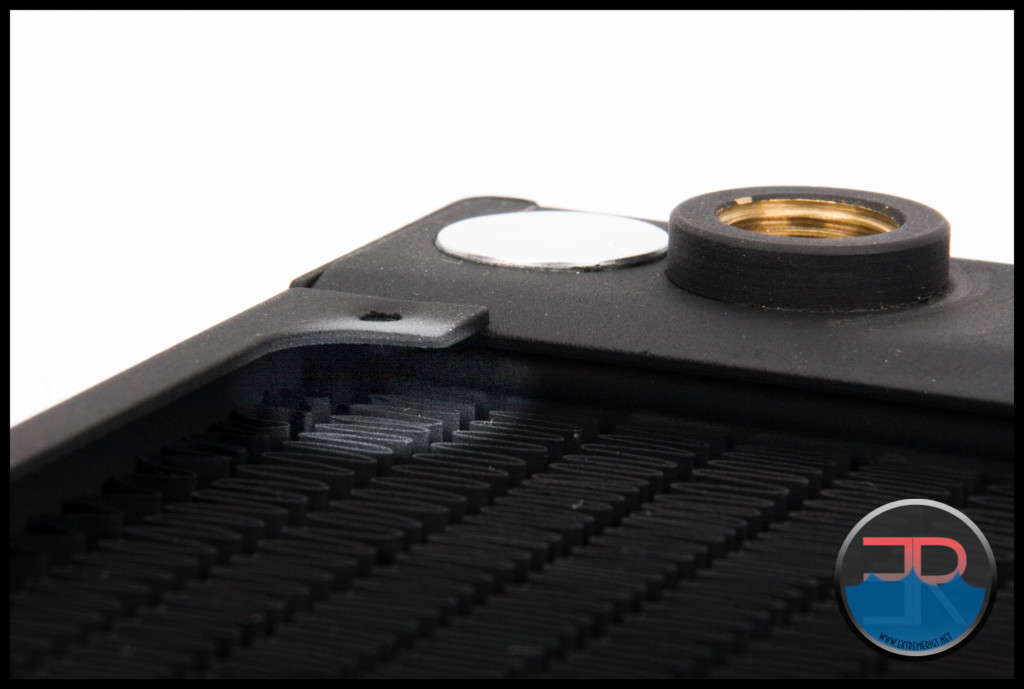 The mounting holes are not located directly above tubes, however they are close so it’s unusual that EK have chose not to incorporate screw protection plates.
The mounting holes are not located directly above tubes, however they are close so it’s unusual that EK have chose not to incorporate screw protection plates.
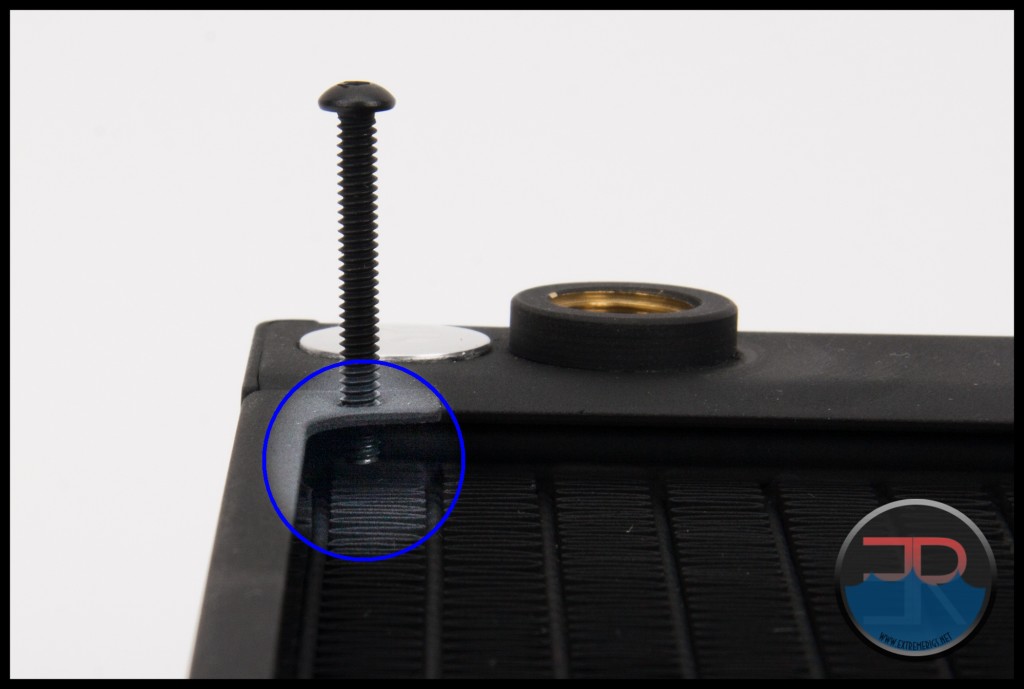
The CE 140 comes equipped with just 2 ports in total, either of which can be used for inlet or outlet.
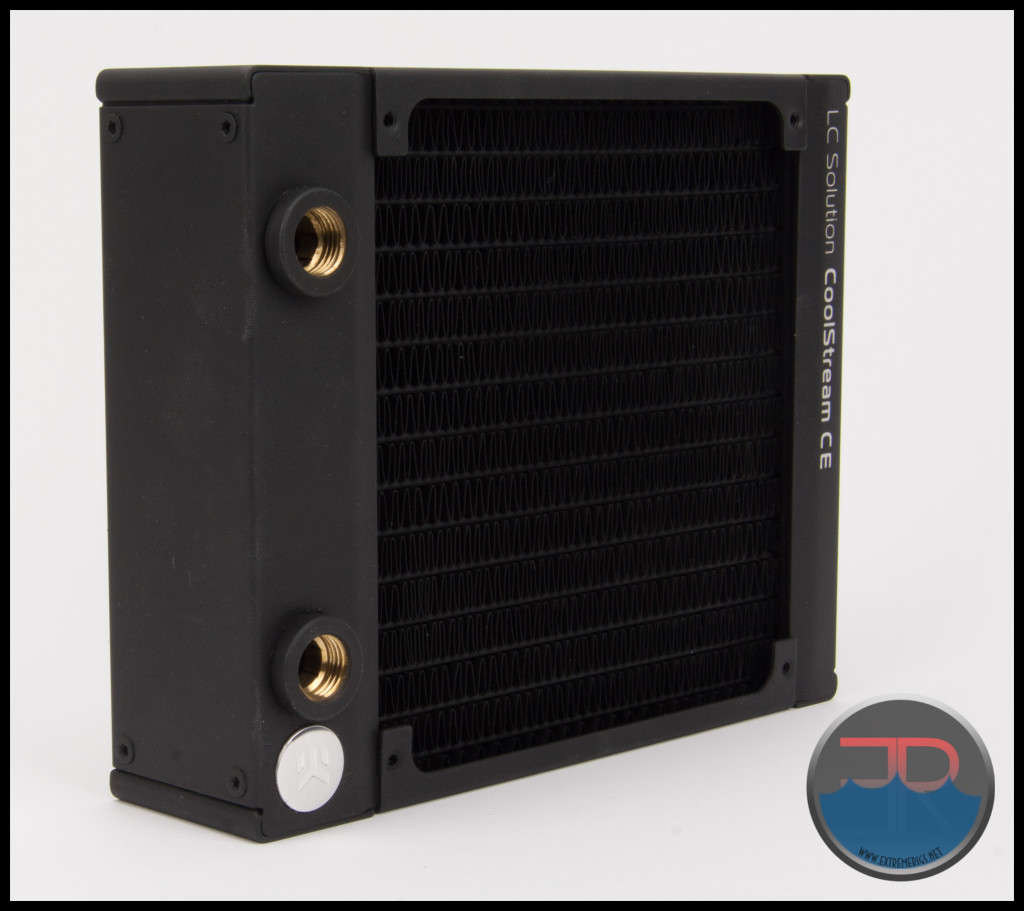 No alternative port options are fitted on the CE 140.
No alternative port options are fitted on the CE 140.
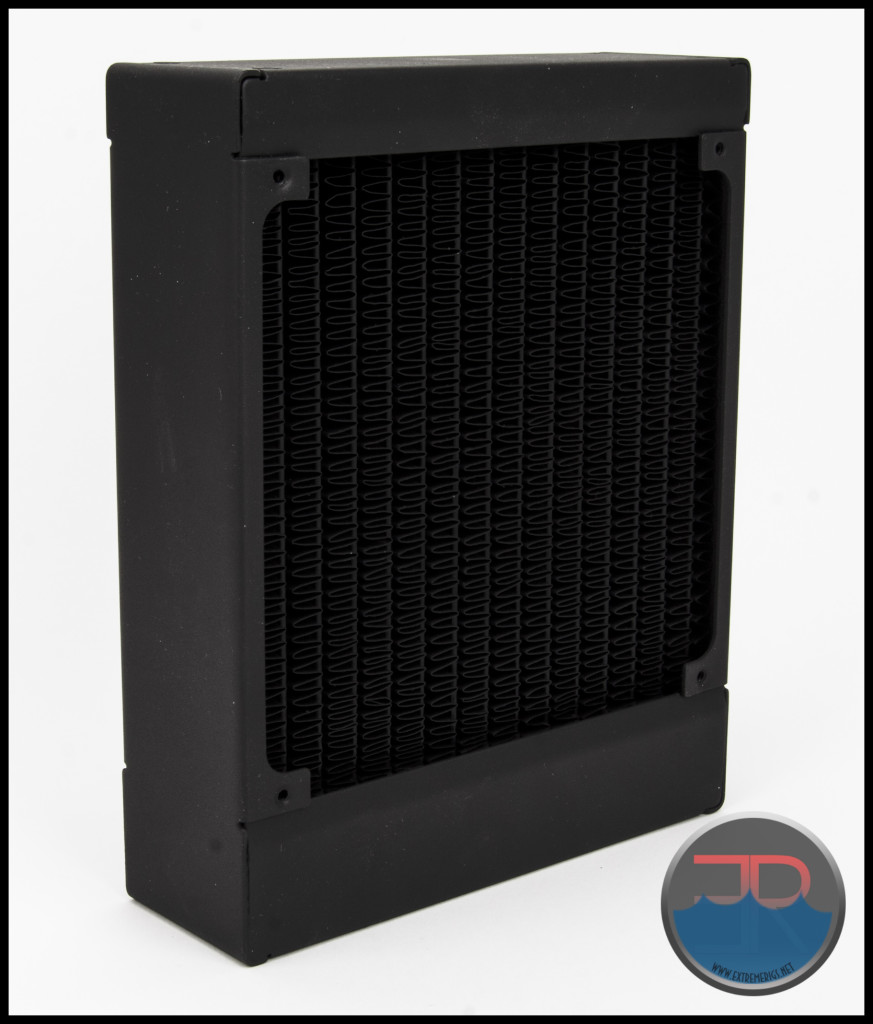 Unfortunately there is no dedicated fill/drain port on the return end either.
Unfortunately there is no dedicated fill/drain port on the return end either.
Technically the ports are extensions which screw into the tanks which are inside the external casing. The port extensions help keep the core from moving around inside the casing.
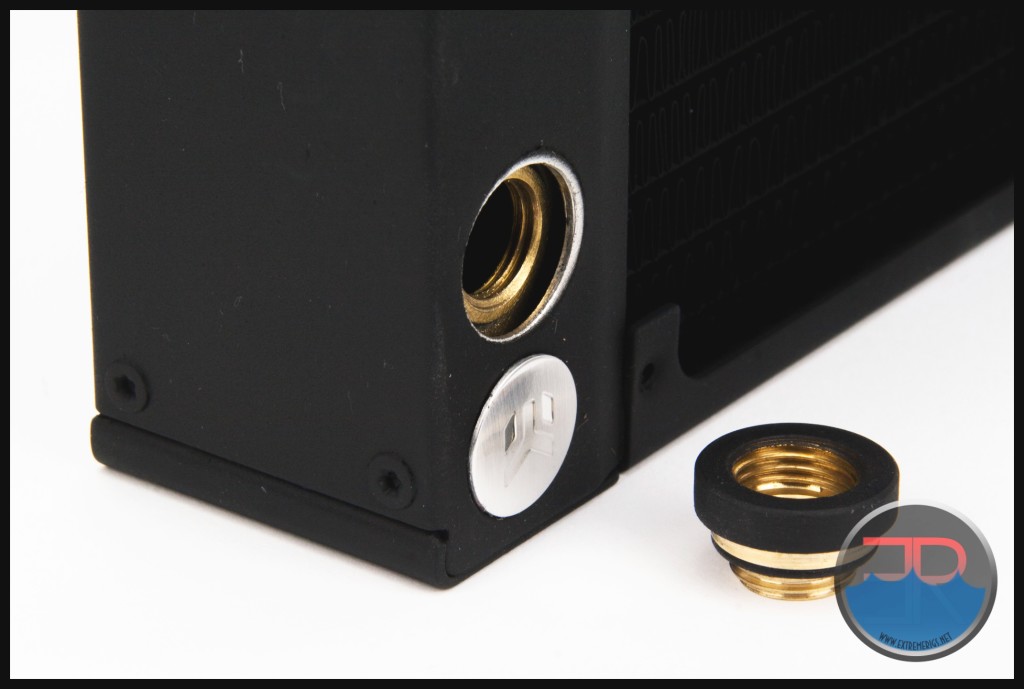 The extenders often unscrew when removing fittings, and it is the 9mm allen key (missing from the review sample) which is required to tighten them up.
The extenders often unscrew when removing fittings, and it is the 9mm allen key (missing from the review sample) which is required to tighten them up.
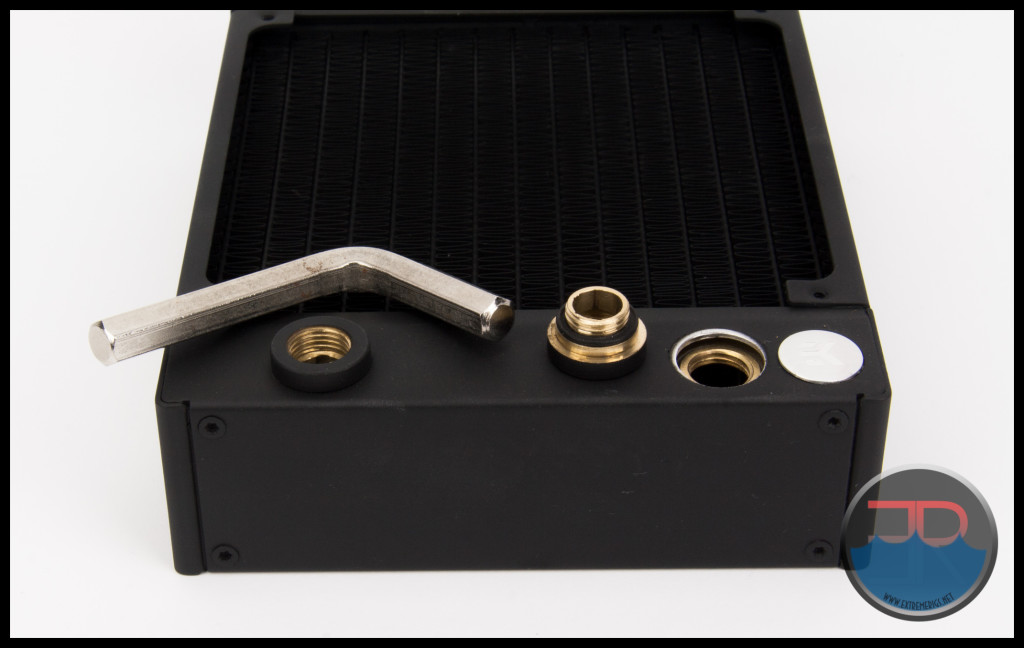 On various EK rads we have seen the finish of the port extenders differ. Some are untreated brass as our sample has, while others are nickel plated. With fittings in place only the painted section of the extender is visible, so whichever is supplied is not really of any concern.
On various EK rads we have seen the finish of the port extenders differ. Some are untreated brass as our sample has, while others are nickel plated. With fittings in place only the painted section of the extender is visible, so whichever is supplied is not really of any concern.
The CE 140’s square boxy design is quite stylish. Add your choice of fittings and it’s nearly ready for business.
With EK’s 140mm Vardar fans coming back on line last week, we have no doubt we’ll see many CE/Vardar combos popping up in builds very soon.
After testing was complete I dis-assembled the CE 140 for an inspection of the end tanks and was pleased to find nothing out of the ordinary.
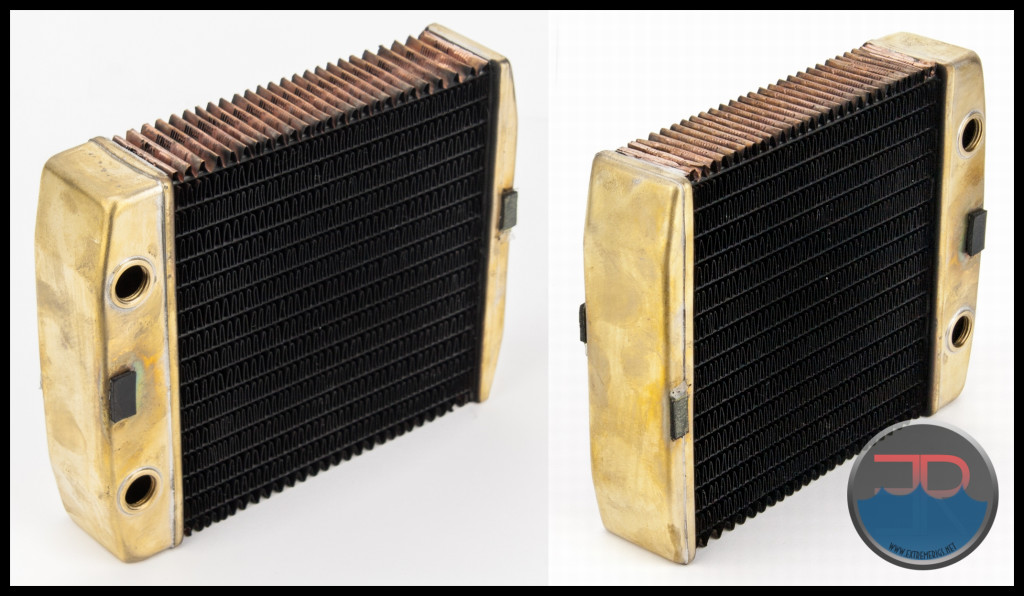
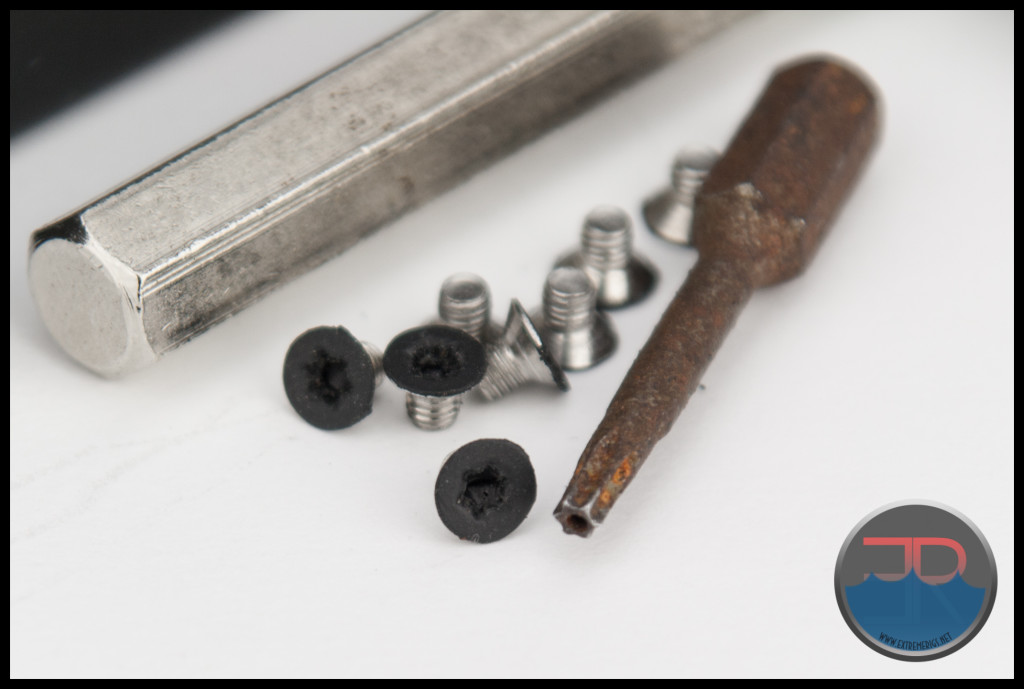 The relative ease at which the CE 140 comes apart makes it an ideal candidate for custom paintwork of the casing panels. A Torx driver (anti tamper) bit as pictured above will be required for dismantling and re-assembly.
The relative ease at which the CE 140 comes apart makes it an ideal candidate for custom paintwork of the casing panels. A Torx driver (anti tamper) bit as pictured above will be required for dismantling and re-assembly.
So here we have a 45mm thick radiator with a medium FPI count that has just 2 ports and no protection plates. The build quality and finish on the sample was excellent. It has a stylish look but it is lacking a few features.
Let’s see how it performs…
Flow Rate Testing
The Data
As all the testing was performed with the exact same equipment (except the 140mm Noctua Industrial fans replace the 120mm GT fans), using the exact same methods as was used in the 360mm round-up we have decided to keep this review uncluttered by keeping our testing methodology, test set-ups and equipment used in a single location. To see exactly how the tests were carried out, details of the test set ups and equipment used, please head over to the RRU Test Setup page.
Restriction Test
It’s generally agreed that radiators are one of, if not the least restrictive components in the water cooling loop. There are some exceptions however, so this must still be verified through testing:
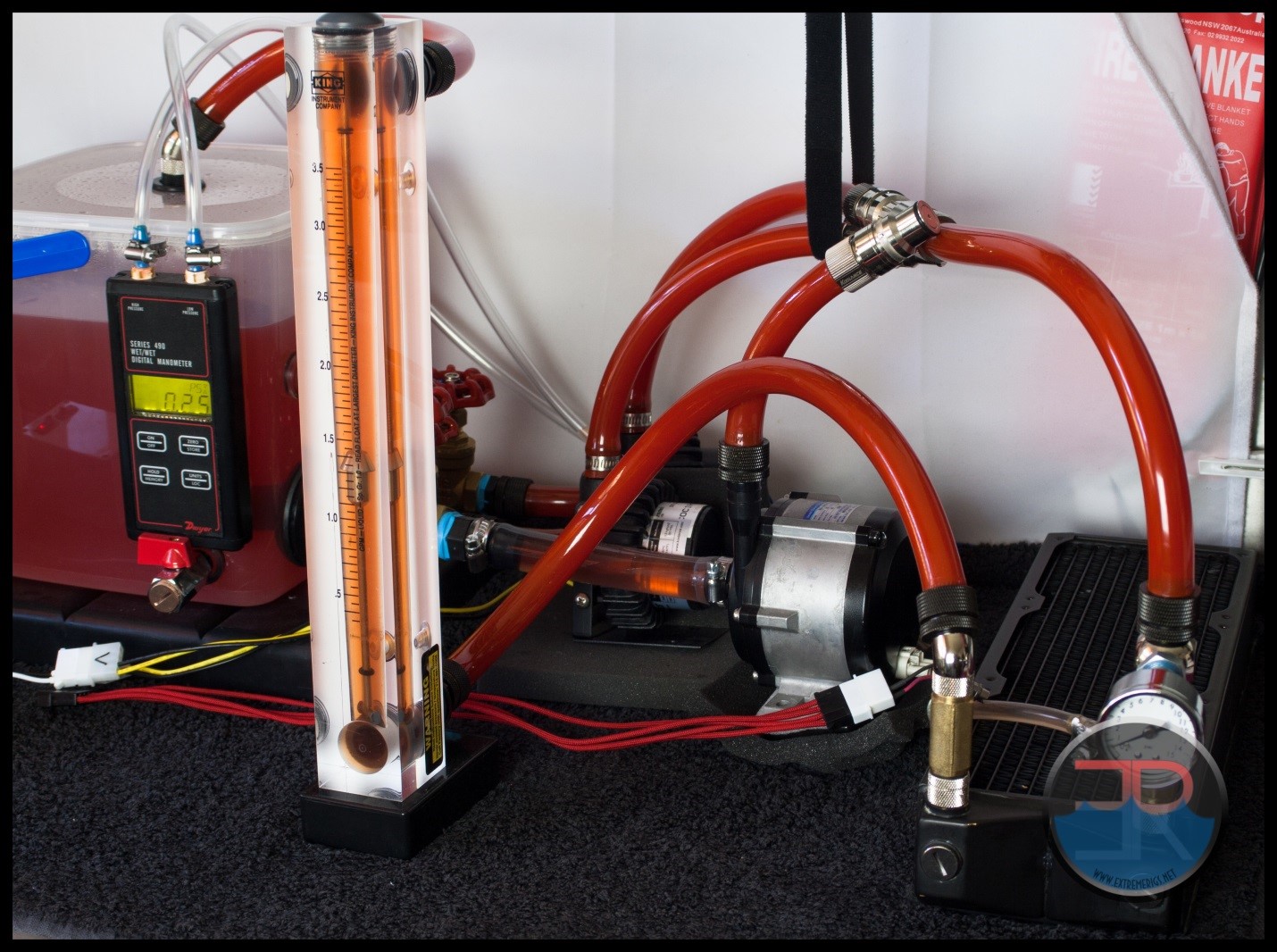 The above photo is for referencing the restriction test bench The CE 140 is not loaded so please disregard the data in the picture as it does not relate to the its test results.
The above photo is for referencing the restriction test bench The CE 140 is not loaded so please disregard the data in the picture as it does not relate to the its test results.
Here is the raw data at the tested flow rates, displaying the measured Differential Pressure across the radiator as flow rate was increased.
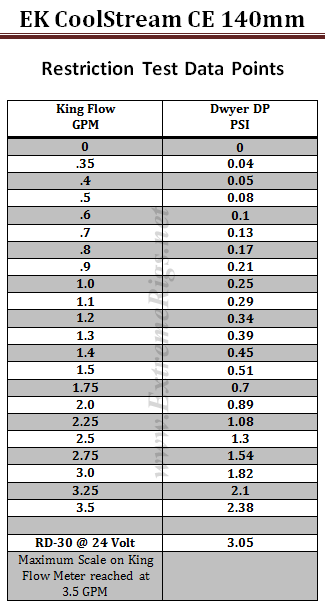 The table numbers indicate that this CE 140 is a low restriction radiator. However numbers in isolation can only tell half the story. By plotting against other components it more easily shows the whole story.
The table numbers indicate that this CE 140 is a low restriction radiator. However numbers in isolation can only tell half the story. By plotting against other components it more easily shows the whole story.
We have used a HeatKiller 3.0 CPU block as the reference in this next plot for two reasons. Firstly there is no chance of the plot being cluttered by curves overlapping and secondly it gives a reference point against a fairly common loop component of average restriction.
As with all previous radiator restriction plots, we have limited the maximum flow rate displayed to 2.0 GPM as we suspect there are very few systems that operate above 2.0 GPM. For more information on how to read a restriction plot check out our guide.
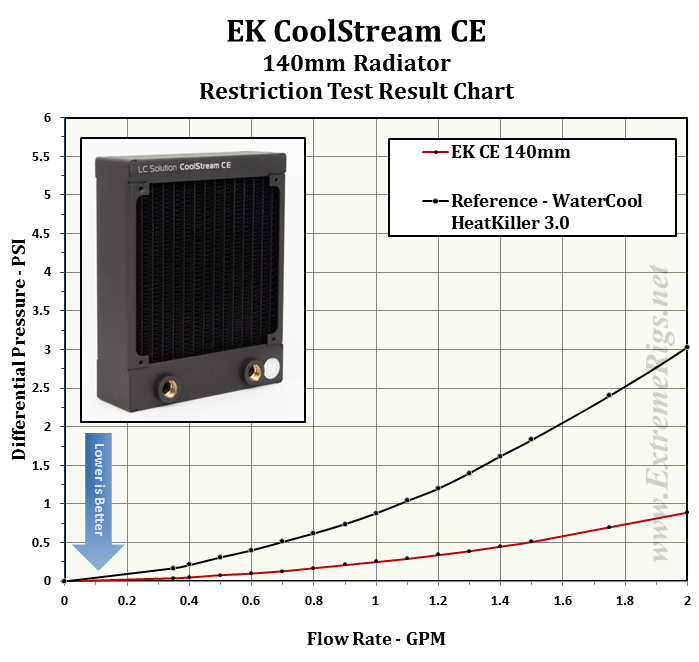 This plot indicates the CE 140 as a low restriction loop component when compared to a CPU block of average restriction, but what about other radiators?
This plot indicates the CE 140 as a low restriction loop component when compared to a CPU block of average restriction, but what about other radiators?
The next three plots show the restriction level at three different flow rates compared to the other 140mm radiator that have been tested. We consider the chosen GPM rates to represent systems which have low, medium and high flow rates.
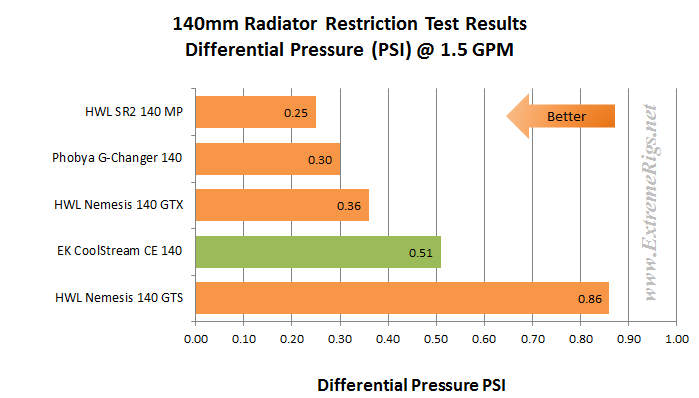 While the CE 140 has a higher restriction level than 3 other rads, the CE 140 is not overly restrictive, just more so than some.
While the CE 140 has a higher restriction level than 3 other rads, the CE 140 is not overly restrictive, just more so than some.
This next plot shows each of the 140mm radiator results at all data points up to 2.0 GPM.
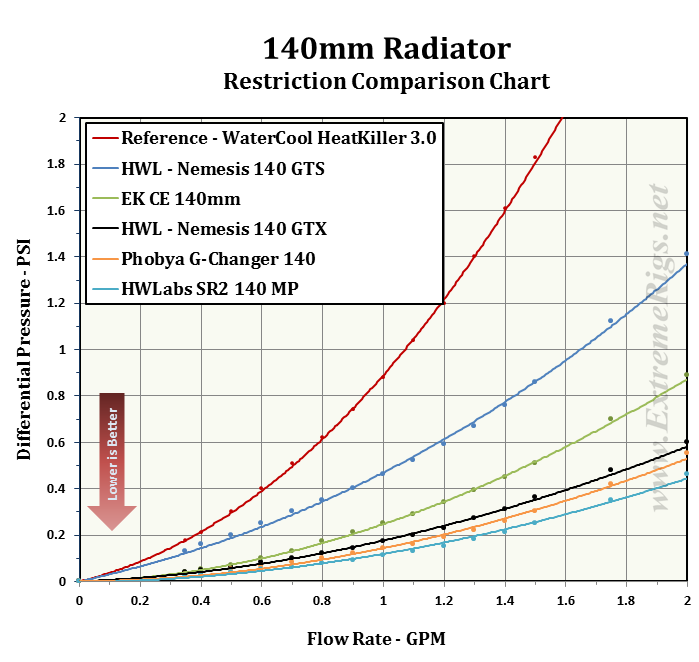 Lets now take a look at where the CE 140 fits in relation to all the radiators we have tested. For this plot, only results for 1.0 GPM have been used for the comparison.
Lets now take a look at where the CE 140 fits in relation to all the radiators we have tested. For this plot, only results for 1.0 GPM have been used for the comparison.
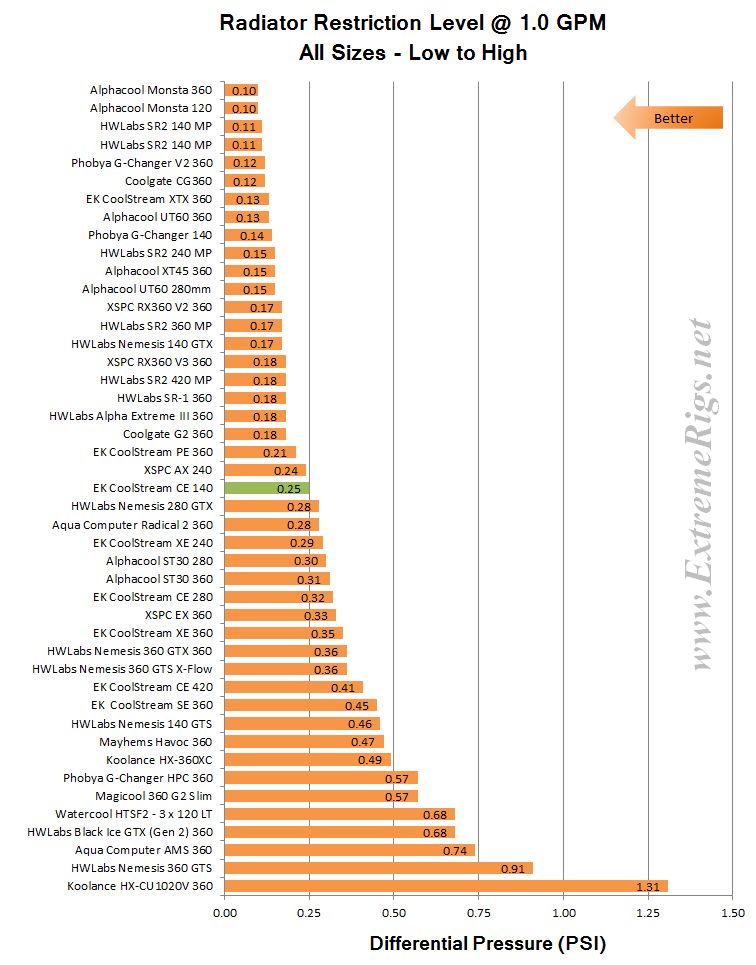 When put into context with all the radiators at 1.0 gpm, we rate the CE 140 as a medium restriction radiator.
When put into context with all the radiators at 1.0 gpm, we rate the CE 140 as a medium restriction radiator.
While we are looking at restriction, you may find it interesting if we isolate only EK radiator results to compare against the CE 140.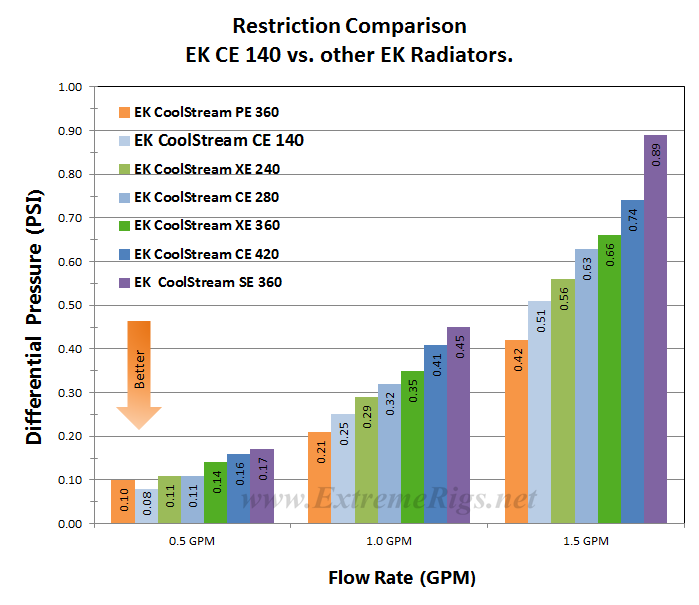
Onwards to Thermal Performance!
Thermal Testing
The Thermal Data
A total of 6 tests were conducted at 1.0 GPM with fan speeds of 750 rpm, 1300 rpm and 1850 rpm being run in ‘Push Only’ and ‘Push/Pull’. All inclusive this testing takes between 40 – 50 hours of logging time (plus processing the data) to get the results that are presented.
Below is the final data results gathered from at least 5 data logging runs at the flow rate and fan rpm combination. The most stable 15 minute period from each logging run was used and then averaged with the other runs to obtain the data for the table below. A total of 16 temperature sensors are used in the thermal test chamber (8 air in, 2 air out, 3 water in, 3 water out). Each sensor takes a reading every second and is logged via a CrystalFontz unit.
The data in the table below is the averaged results of the logging runs which has then been used to create all the plots and tables there-after.
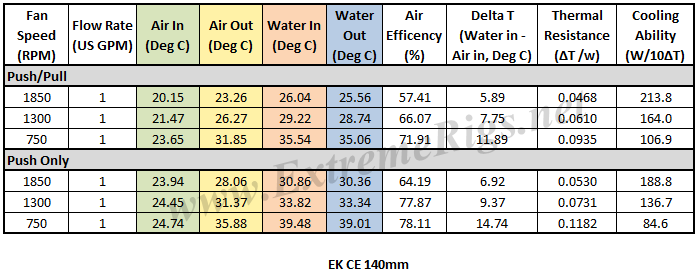 The performance metric of critical importance is the delta between the warm coolant temperature in and the cool ambient air temperature going into the radiator. Given that the system is well insulated and in equilibrium and we know the heat input to the system then we can also calculate a very important number. That number is the amount of power required to raise the coolant temperature by set amount. That amount is typically 1C or 10C. The latter is a more useful reference point.
The performance metric of critical importance is the delta between the warm coolant temperature in and the cool ambient air temperature going into the radiator. Given that the system is well insulated and in equilibrium and we know the heat input to the system then we can also calculate a very important number. That number is the amount of power required to raise the coolant temperature by set amount. That amount is typically 1C or 10C. The latter is a more useful reference point.
Let’s take a look at the Delta T results from the tests. Note that the extrapolation of the curve is much more sensitive to error than in the tested range.
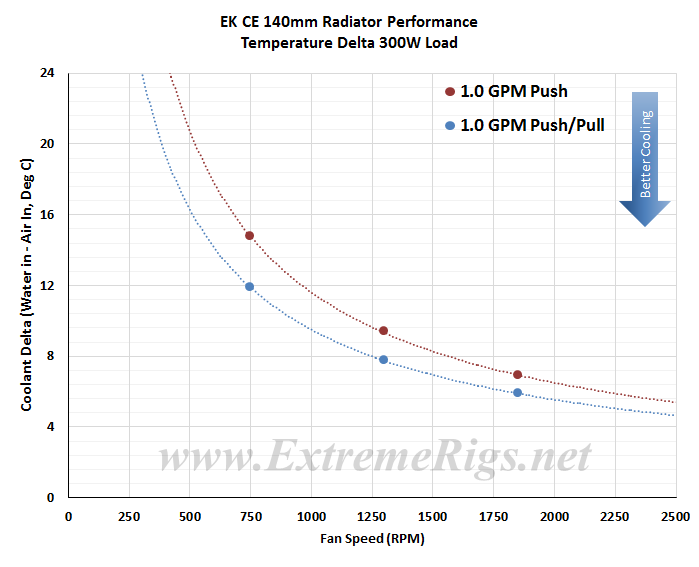 I was not too concerned about the actual delta numbers but instead the trend pattern. As we should expect, the deltas come down significantly as the fan speed is increased.
I was not too concerned about the actual delta numbers but instead the trend pattern. As we should expect, the deltas come down significantly as the fan speed is increased.
Delta T results (as above) are not always helpful when thinking about how many radiators you would need to cool your system. Instead it’s more useful to know the metric of W/delta C. This metric is plotted below. It tells us how many watts are dissipated by the radiator when the coolant rises 10C above ambient temperatures. (W/10 Delta T):
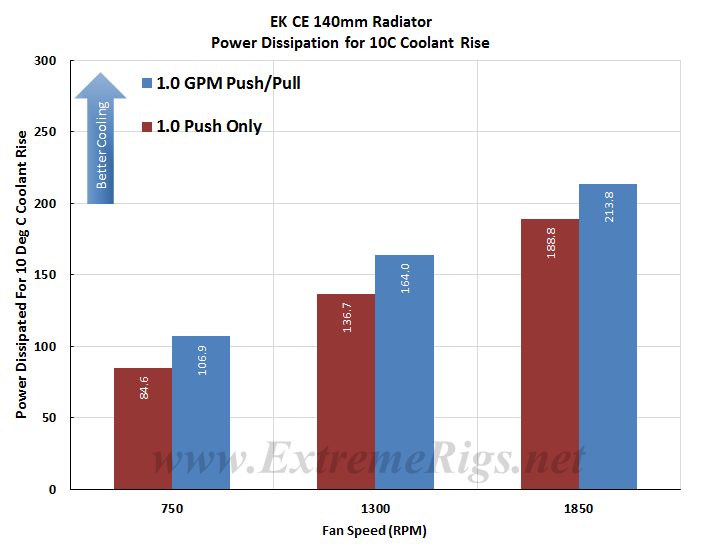 This bar chart can be deceiving for comparing performance between the 2 fan assemblies. The average difference at the same fan speed was ~83.5%, but ranged from ~79% at 750 rpm to 88% at 1850 rpm. Without delving deeper into the results these percentage numbers could also leave one with the wrong interpretation of this data so we’ll jump the gun a little to explain this better before moving on.
This bar chart can be deceiving for comparing performance between the 2 fan assemblies. The average difference at the same fan speed was ~83.5%, but ranged from ~79% at 750 rpm to 88% at 1850 rpm. Without delving deeper into the results these percentage numbers could also leave one with the wrong interpretation of this data so we’ll jump the gun a little to explain this better before moving on.
Starting with the 21% variance at 750 rpm, we conclude that the Push/Pull was much more efficient at heat dissipation than Push Only at this fan speed and resulted in the greater variance between the results.
Likewise but in reverse, the low 12% variance at 1850 rpm can be attributed to Push Only being very efficient while in Push/Pull the efficiency in heat dissipation has dropped off.
This same data can now be plotted on a chart so that an end user can interpolate their own fan speed. Note again that the extrapolation of the curve is much more sensitive to error than in between the tested range.
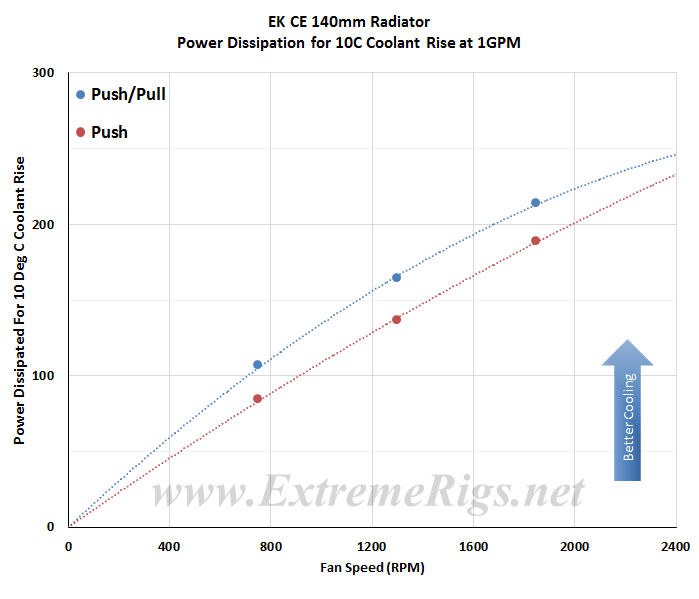 Using the explanation above, we can see the CE 140’s Push/Pull result does have a great start but is begins to curve over while the Push Only on the other hand has almost a straight line showing more efficient use of air flow as the fan speeds increase.
Using the explanation above, we can see the CE 140’s Push/Pull result does have a great start but is begins to curve over while the Push Only on the other hand has almost a straight line showing more efficient use of air flow as the fan speeds increase.
This correlates well with the Air Efficiency data in our results table. at the top of this page.
Now let’s analyze that data some more…
Data Analysis
This first table shows the CE 140’s Watts/10 Delta Temp numbers in a quick glance chart format.

Using this data we can effectively show percentage gains/losses relative to a reference point. It’s an interesting way to show gains/losses while changing a variable.
So, let’s focus on 1300 RPM as our reference and see how much gain or loss in performance we get by changing fan speed.

From these results we see the Push Only being very linear with rpm changes. While being pleased with a 38% performance gain with a fan speed increase, we are not so impressed about the 38% loss in performance when reducing fan speeds. While in Push/Pull the variation is much less dramatic. This all indicates the CE 140 core is best tuned for medium to high air flow as the core is probably too dense for low speed fans to move enough air through the core. While at the highest air flow the performance is tapering off because the core is not thick enough to use the extra airflow as effectively.
So from the data above we have a good idea of how the CE 140 radiator performs relative to itself. But there is a large selection of 140mm radiator models to choose from.
We have some other 140mm radiators with thermal testing completed. So let’s put the CE 140’s results into some comparison charts.
Push Only Data vs Competition
Let’s focus on the Push Only results for now and come back to the Push/Pull data later.
Let’s start with 750 RPM and see how the CE 140 compares.
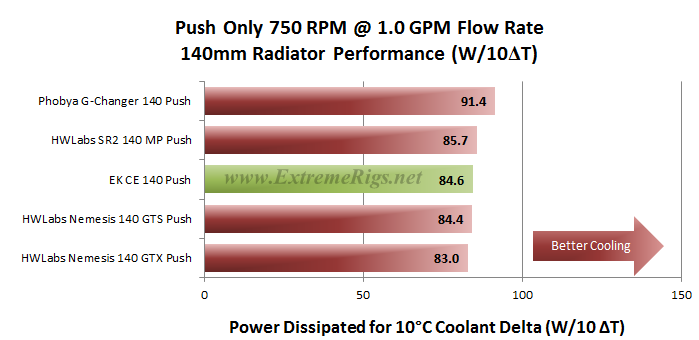
While we hesitate to make predictions, this is right about where we expected the CE 140 to fit in given the varying thickness and core density that each of the radiators have. The rads which had better performance are both thicker but have a lower fin count allowing better efficiency. The Nemesis GTS below the CE 140 is 33% thinner but has equal performance demonstrating great air deficiency.
Now let’s look at 1300 rpm:
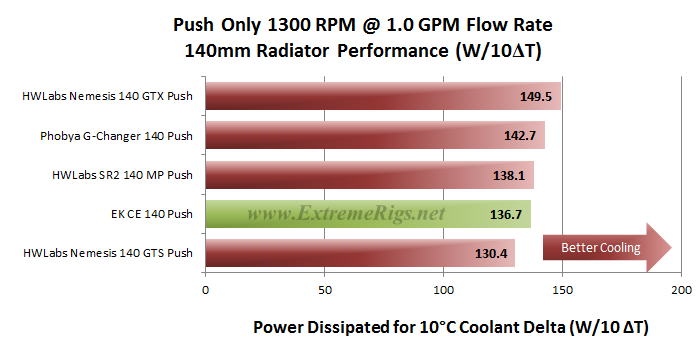
At 1300 RPM the CE 140 places fourth. With more air flow the thicker rads gain the advantage.
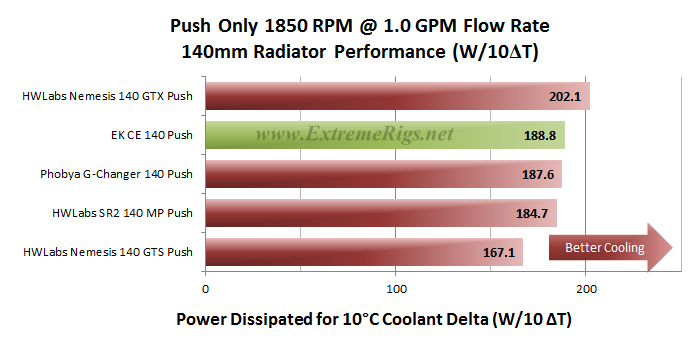 At 1850 rpm the CE 140 jumps up into 2nd place. It’s higher fin count now trumps the thicker lower FPI rads.
At 1850 rpm the CE 140 jumps up into 2nd place. It’s higher fin count now trumps the thicker lower FPI rads.
This all fits nicely with our earlier assessment of the CE 140 being tuned best for medium to high air flow fan assemblies. Therefore we expect similar rankings in the Push/Pull comparisons, but we always get some surprises.
Let’s find out how the CE 140 performs with Push/Pull fans.
Push/Pull Data vs. Competition
Firstly the 750 rpm:
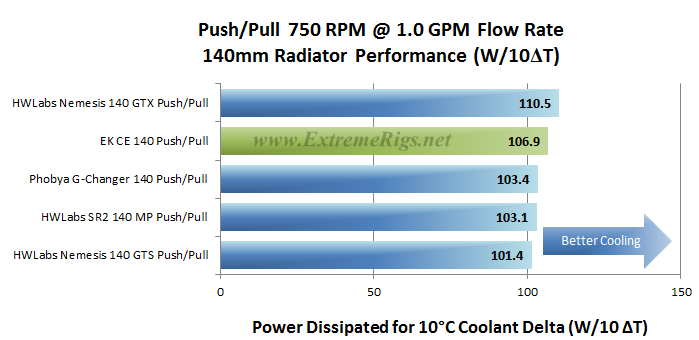 The CE 140 continues it’s great performance taking another 2nd place and is just ~3% behind the Nemesis 140 GTX which is becoming the dominant radiator of the test group.
The CE 140 continues it’s great performance taking another 2nd place and is just ~3% behind the Nemesis 140 GTX which is becoming the dominant radiator of the test group.
Let’s move to 1300 rpm:
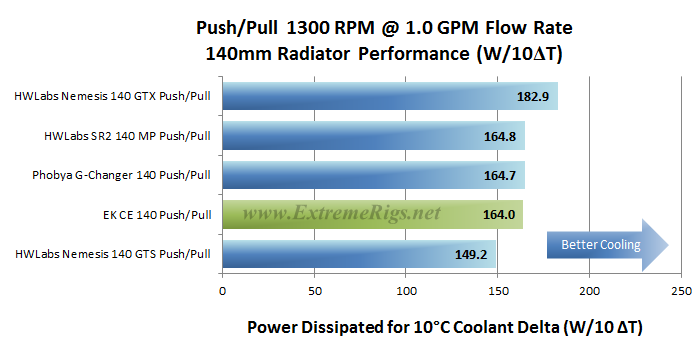
In the 1300 rpm Push/Pull category the CE 140 result lands it in 4th place, but the 2nd to 4th place results are virtually identical and with our test error margin, so we have to call it a 3 way tie for second place. Given that the CE 140 is the thinner of these 3 radiators it is therefore the better in terms of space efficiency vs. performance.
Now 1850RPM:
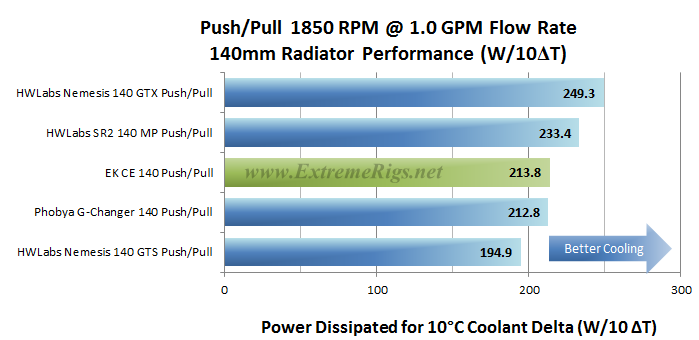 At 1850 rpm Push/Pull the CE 140 places 3rd while the 2 thicker HWLabs samples streak away from the pack.
At 1850 rpm Push/Pull the CE 140 places 3rd while the 2 thicker HWLabs samples streak away from the pack.
Let’s now combine the Push Only and Push/Pull results of our 1.0 GPM flow rate tests. Sometimes these combined plots show up some points of interest.
Again the 750 rpm first:
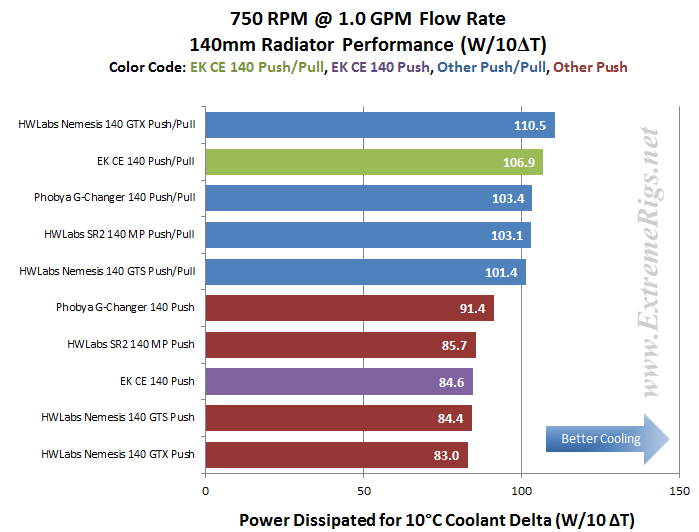
Nothing looks out of place here..
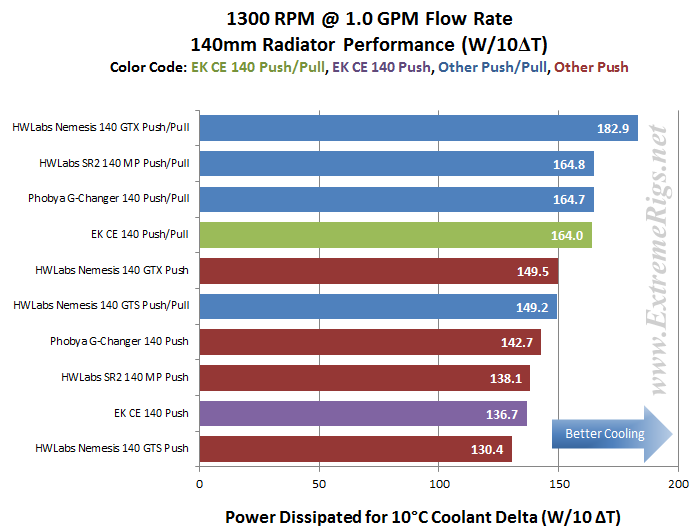
At 1300 rpm everything looks in order given the data we’ve already reviewed.
It was exactly the same with the 1850 combined.
And one last view, plotted as curves and adding some extrapolation.
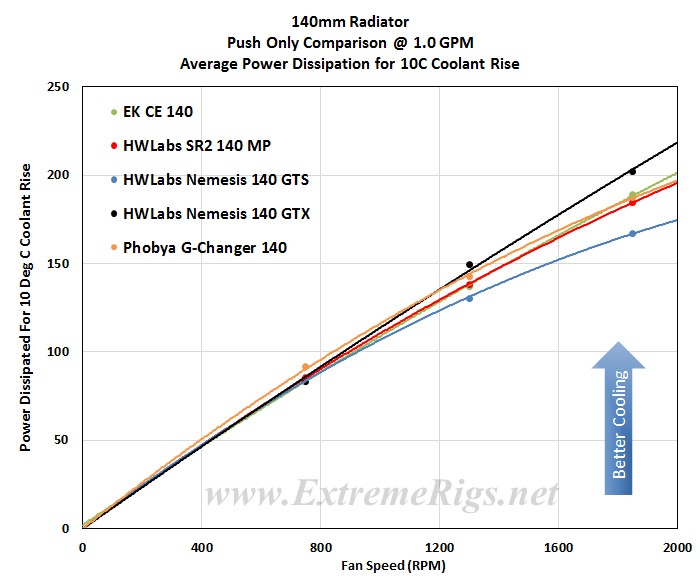 This perhaps best shows just how close the results are!
This perhaps best shows just how close the results are!
In the Push/Pull setup we see a bit more separation occurring. As the fan speeds are increased the different core designs show their strengths and weaknesses.
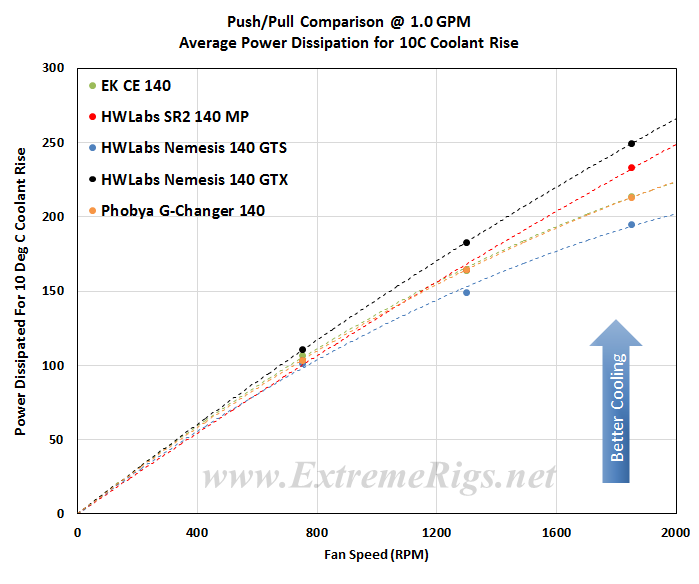 The CE 140 and Phobya G-Changer have such similar results that the EK result is somewhat hidden behind the Phobya’s. This is actually a very good thing for the CE 140 because it is only 45mm thick vs. the 60mm thickness of the Phobya.
The CE 140 and Phobya G-Changer have such similar results that the EK result is somewhat hidden behind the Phobya’s. This is actually a very good thing for the CE 140 because it is only 45mm thick vs. the 60mm thickness of the Phobya.
From all the test results we created “Average Performance Factor” charts for both Push and Push/Pull. We then made a combined plot of the average called the “Master Performance Factor”. The radiator with the best cooling ability (W/10ΔT) at each rpm was awarded a score of 100. Each other radiators W/10ΔT result was scored as percentage of the top performer.
This way of looking at the comparison takes away any advantages that a radiator may have at higher or lower fan speeds and looks at an overall average. While this appears fair it does tend to favor those radiators that are all-rounders and those radiators which do very well at high RPM. Most users should be more focused on their specific use case.
Here are the CE 140’s percentage scores at each data point:
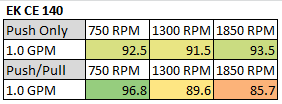 As these percentage scores are relative to the best performer at each data point, we again advise readers to cross reference specifications and results for each radiator and keep in mind your intended fan assembly and speed.
As these percentage scores are relative to the best performer at each data point, we again advise readers to cross reference specifications and results for each radiator and keep in mind your intended fan assembly and speed.
The percentage numbers in the table above offer another way of looking at the CE 140’s results. But for our scoring system we need a way to reduce the categories while retaining the data. To do this we average the results for each fan assembly type giving us Averaged Performance Factors. We calculate this for Push Only, Push/Pull and finally an average of everything.
Firstly – the Push Only APF:
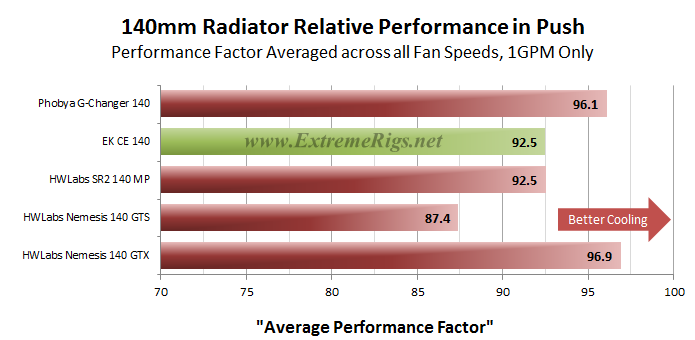 With a 92.5% averaged Push Only result the CE 140 places equal 3rd. This is an excellent result when we consider the core thickness differences.
With a 92.5% averaged Push Only result the CE 140 places equal 3rd. This is an excellent result when we consider the core thickness differences.
Now the Push/Pull APF:
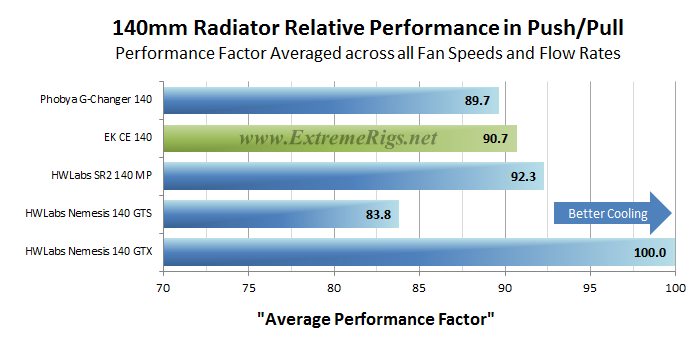 The CE 140 places 3rd in the Push/Pull APF.
The CE 140 places 3rd in the Push/Pull APF.
Finally we created the Master Performance Factor which is calculated from the averaged results of all the Push Only and Push/Pull thermal tests, at all fan speeds.
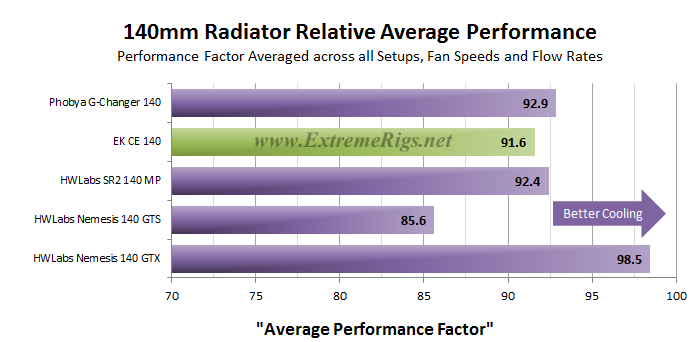 Overall the CE 140 placed 4th in our thermal tests, but by the smallest of margins. The 1.3% difference between 2nd and 4th is very small and on the border of our test error margin.
Overall the CE 140 placed 4th in our thermal tests, but by the smallest of margins. The 1.3% difference between 2nd and 4th is very small and on the border of our test error margin.
Space Efficiency
The CE 140’s thermal results are a great example to consider space efficiency vs. performance so we have used the Average Performance Factor results from the chart above to compile two plots which shows us how it compares to the other rads in terms of performance Vs. space taken.
Firstly is radiator thickness Vs. APF
Here the APF scores were divided by the radiator thickness with the highest (most space efficient) issued a score of 100. Each of the other radiators results was converted to a percentage of the most space efficient radiator’s score.
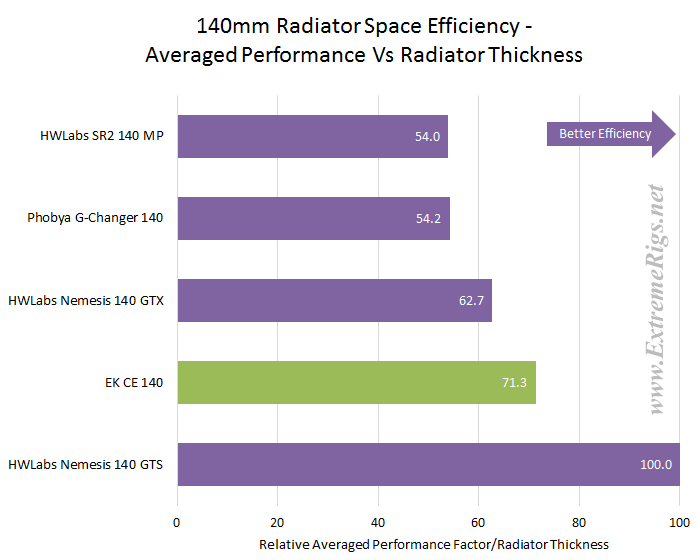
It is always the case that the thinnest rads are the most efficient space users, however as thickness increases the order starts to shuffle around as the varying core designs come into play. The CE 140’s second place demonstrates that the core is well tuned for it’s thickness.
Next we took the APF results for Push/Pull and divided it by the total thickness including the fans and applied the same scoring system. For the Push Only we used the Push Only Vs Push/Pull comparative results and applied the same scoring system when compared against the Push/Pull.
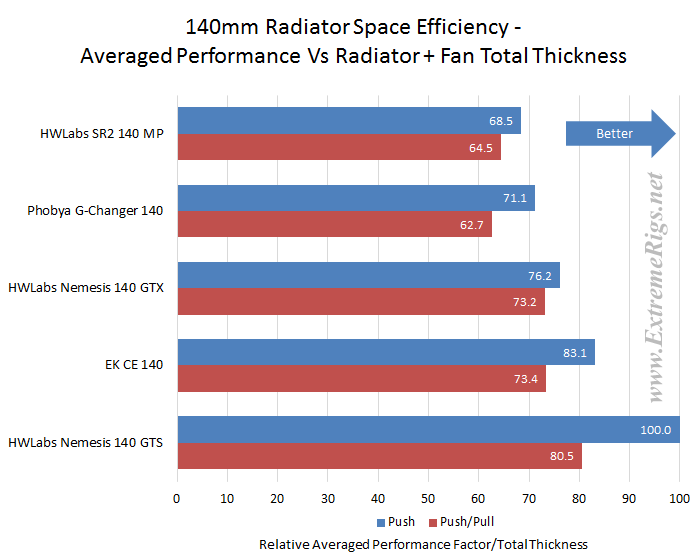 The plots above show us that the CE 140 is very efficient in Push Only for the amount of space it requires. While still ranking second in Push/Pull the thicker rads have closed the gap considerably.
The plots above show us that the CE 140 is very efficient in Push Only for the amount of space it requires. While still ranking second in Push/Pull the thicker rads have closed the gap considerably.
Value Factor
While we were toying around with the APF results, we decided to look at some results vs Price to show which of the 140mm radiators might offer the best bang for buck. Each radiator’s combined APF scores were divided by the radiator cost and again we applied our scoring system of percentage Vs. the best performer of the category.
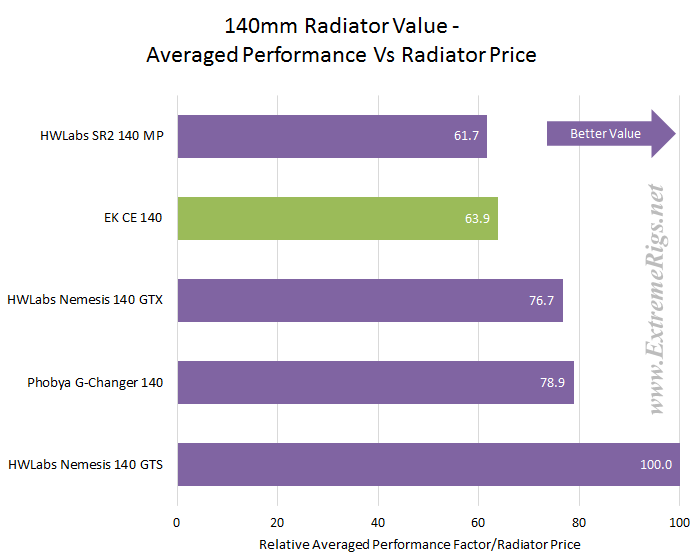 The CE 140’s Value Factor is on the low side which tells us that it doesn’t have very much “bang for your buck”. Another way of thinking about it is that the CE140 costs more to remove the same amount of heat compared to the majority of the test group. In reality the difference is not great, but when visualizing with percentages as we have done the gap appears large.
The CE 140’s Value Factor is on the low side which tells us that it doesn’t have very much “bang for your buck”. Another way of thinking about it is that the CE140 costs more to remove the same amount of heat compared to the majority of the test group. In reality the difference is not great, but when visualizing with percentages as we have done the gap appears large.
Next Up – Summary!
Summary
Thermal Performance
Thermal Performance scores are derived from the relevant Performance Factor scores. We set this scale with 72.5% and below as the 0 mark, with each 2.5% increase from 75% in relative performance adding 0.5 to the awarded performance score.
Note: In a small test group of just five radiators the performance scores do not have a lot of other data to be compared against. Depending on the amount of variance in the results, this could end up with misleading scores based on the comparative performance.
As it turned out there was one radiator which dominated the thermal performance comparisons and each other radiator’s performance was pretty much measured against it as the benchmark.
We must mention that there are likely to be better performing 140mm radiators available which if tested and the results added to our group data would impact on the APF results for every radiator, but as we have just the 5 samples that is what we must score with/against.
Push Only Thermal Performance
- 4/5
The CE 140’s Push Only APF result of 92.5% translated into a very respectable performance score of 4/5. It’s thinner core with a much higher FPI fin count was equal to that of the HWL SR2 which is thicker but has a lower fin count. In our 420mm tests these two radiators also had identical results.
Push/Pull Thermal Performance
- 3.5/5
The Push/Pull APF result of 90.7 translated into a thermal performance score of 3.5 out of 5. The CE 140 had great results in this category having 2 x second places and a third. It was The Nemesis GTX which dominated that pushed all the other rad’s scores down.
Overall Thermal Performance
- 3.5/5
The Master Performance score of 91.6 generates a respectable overall performance score of 3.5/5 especially given how dominant the winning radiator was. Based on the numbers generated this gives the CE 140 a 4th place overall finish. However our test error margin is on the limits here with the 2nd to 4th place rads, so effectively we have to call a three way tie for 2nd place.
Features & Quality – 4/5
The CE 140 from EK features the now standard boxy outer casing which is quite stylish and yet inconspicuous at the same time. The paint finish is decent but could be better. The outer casing can be easily removed for custom painting.
There is only one set of ports on the CE 140, no alternate ports and no ancillary ports so we were left wanting in this department. Also missing are tube protection plates under the fan mounting holes which we believe should be a standard feature these days even if the holes are no located directly above the tubes.
The core is slightly biased towards for medium to high airflow, due to it’s medium thickness 16 FPI core. With a reasonably high FPI count the CE 140 will need cleaning more often than some other radiators.
The medium restriction level should not pose any issues for pump power requirements when planning out your loop, even with multiple CE series radiators in the system.
Summary – Silver Award 4.0/5
The CE 140 proved to be a great all round thermal performer when compared against the other 140mm radiators that we tested. It has a medium restriction level and a medium high FPI count. The design is stylish, the build quality and finish are great, however there are no alternate ports.
It’s 45mm thickness and core design proved to be a perfect match for medium to high air flow scenarios, while still having excellent results with both low and high speed fans in both Push Only and Push/Pull. The space efficiency the CE offers is fantastic, but the cost is slightly higher than the competition to get equivalent performance.
It lacks any optional ports and the paint finish could be better, but it has a stylish design that balances size and performance very well.
Taking equal second place in the overall performance and being 25% thinner than the other 2 radiators with the same performance, The CE140 receives a thoroughly well deserved Silver Award.
Where to buy:
- Performance PCs: EK CE 140 $56.99 + shipping from USA
- EK Webshop: EK CE 140 $56.99 + shipping from Europe










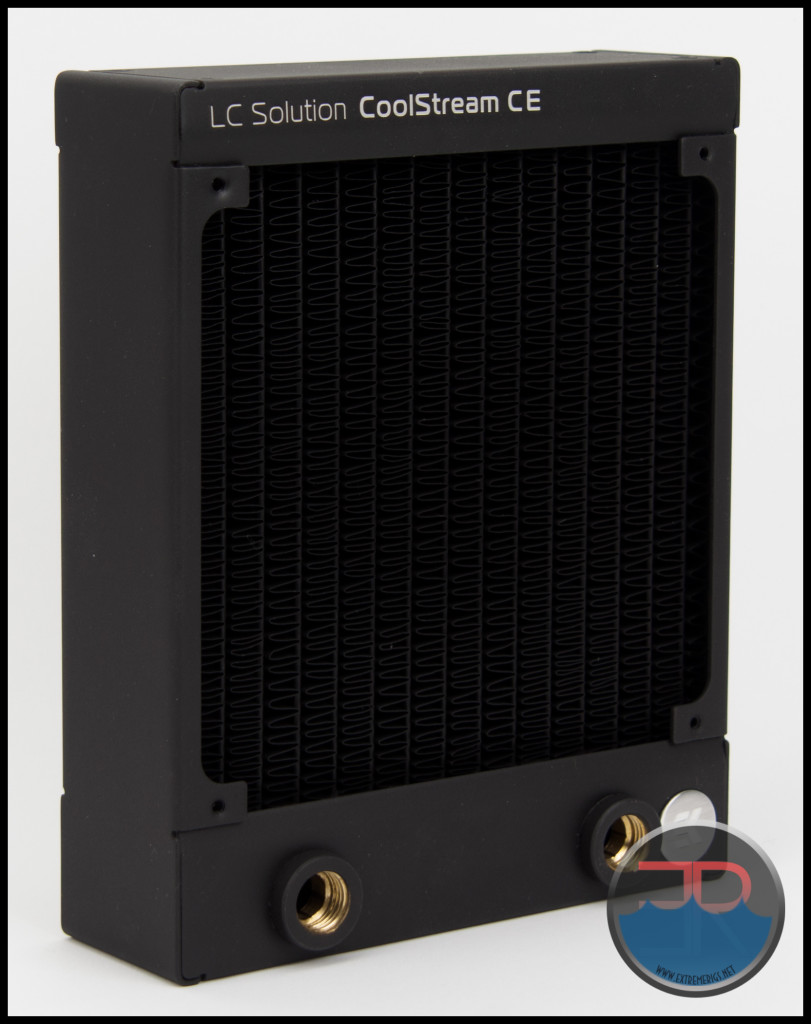

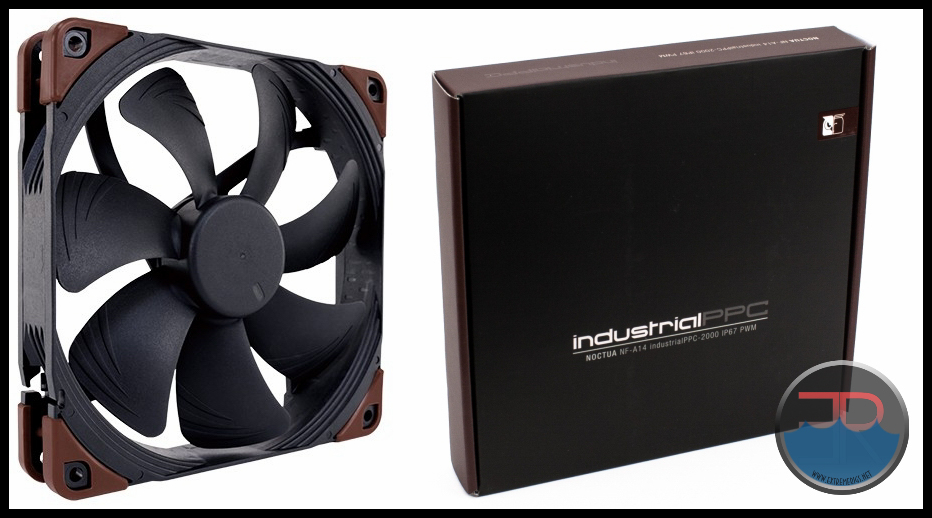
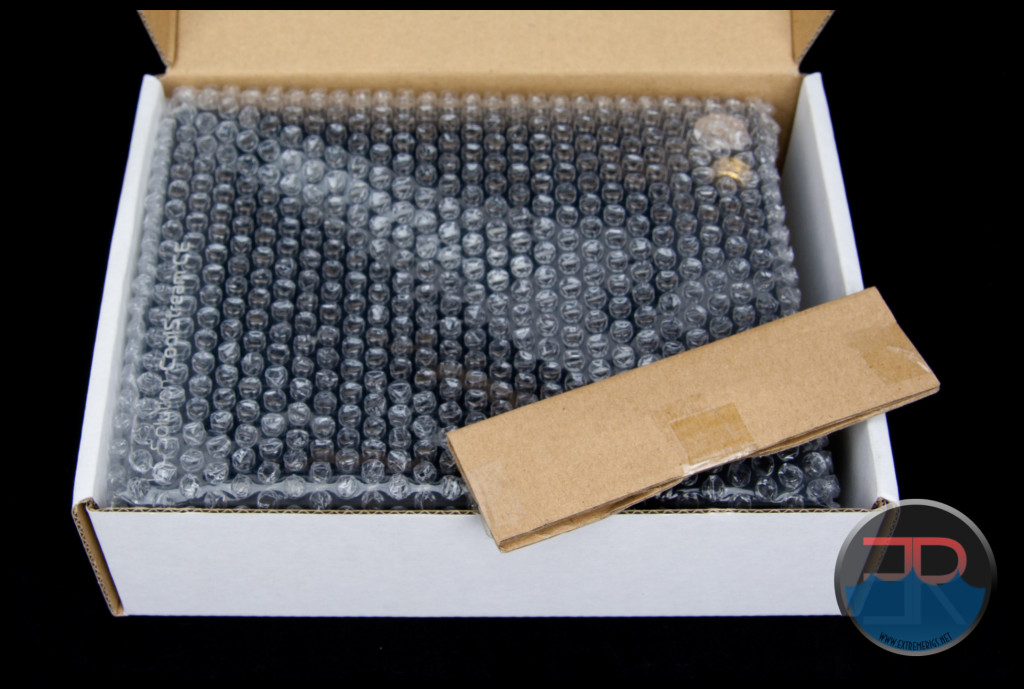
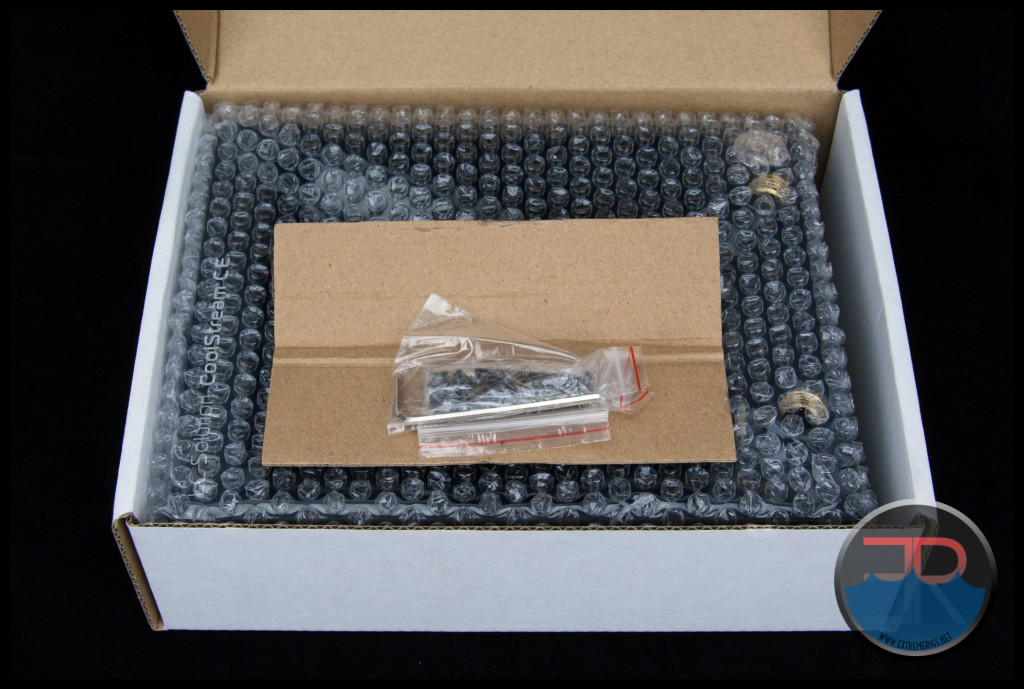
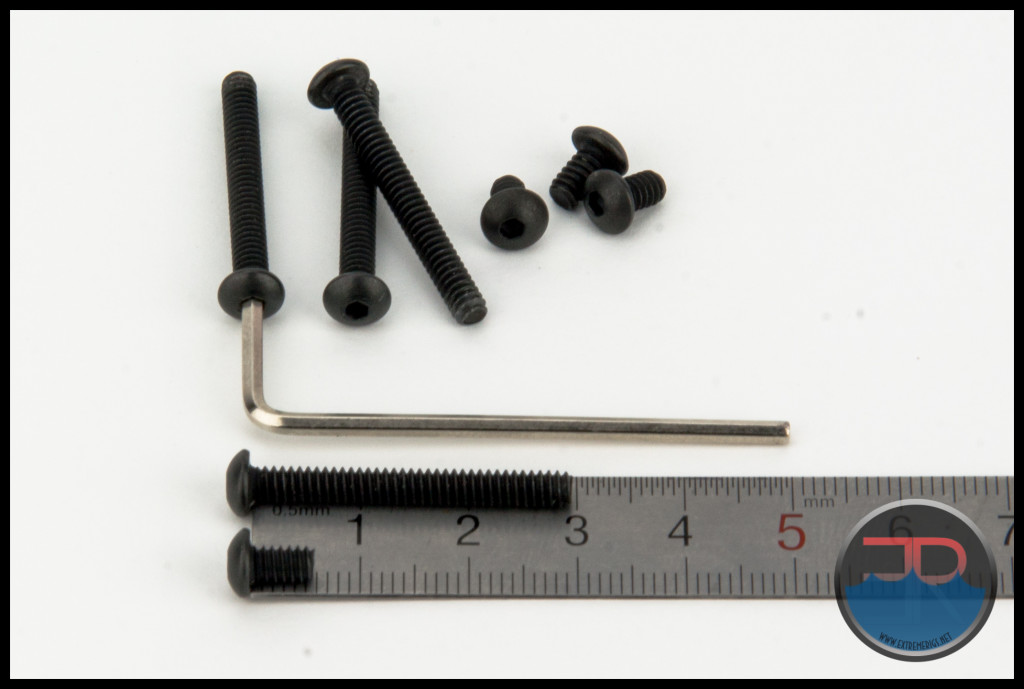
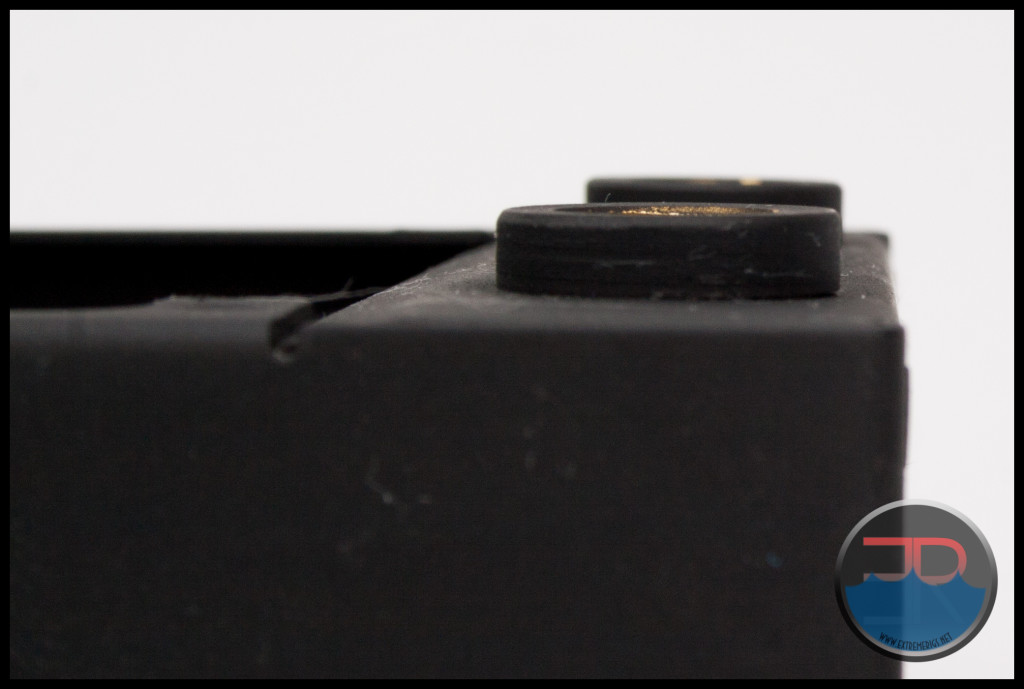

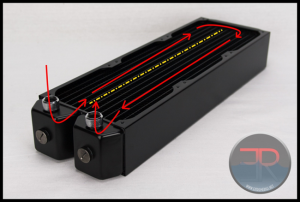
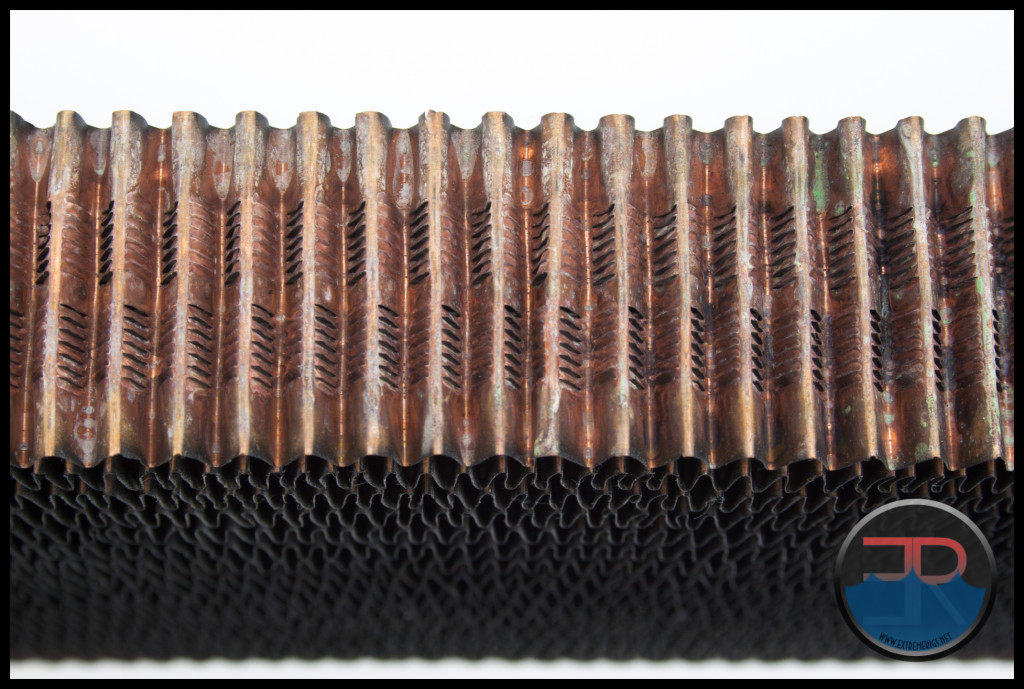
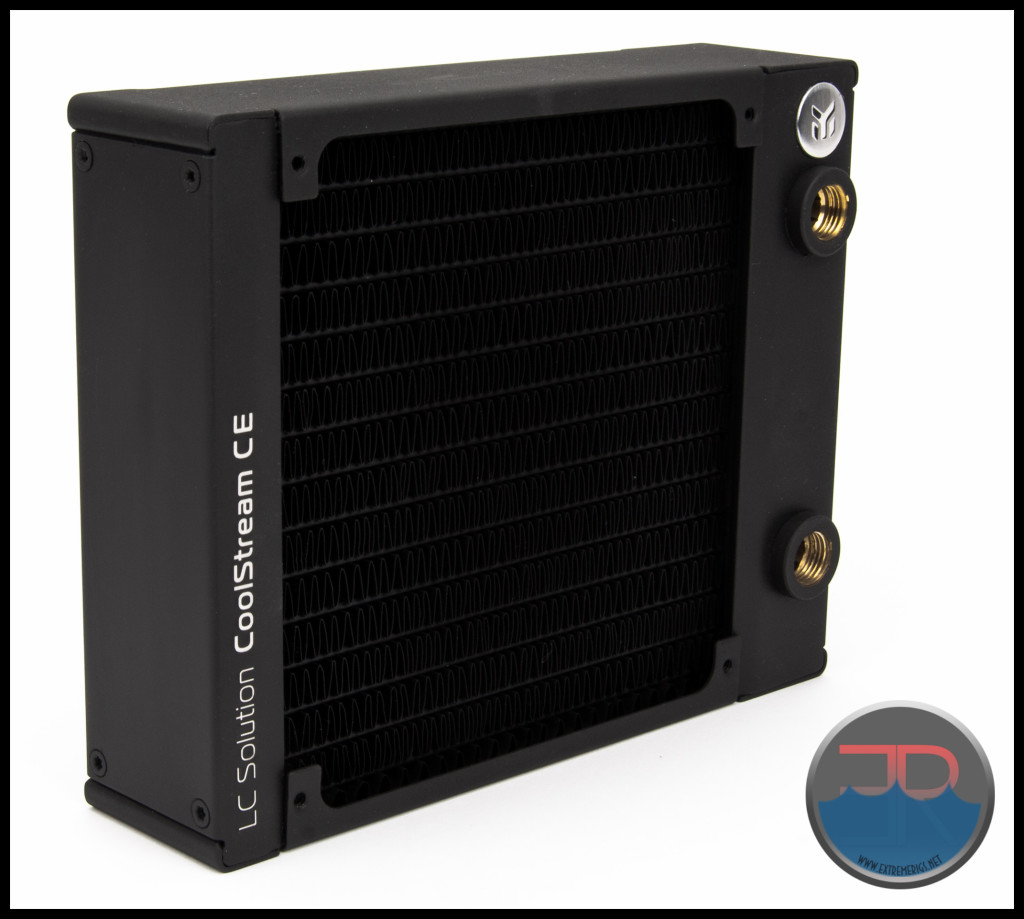
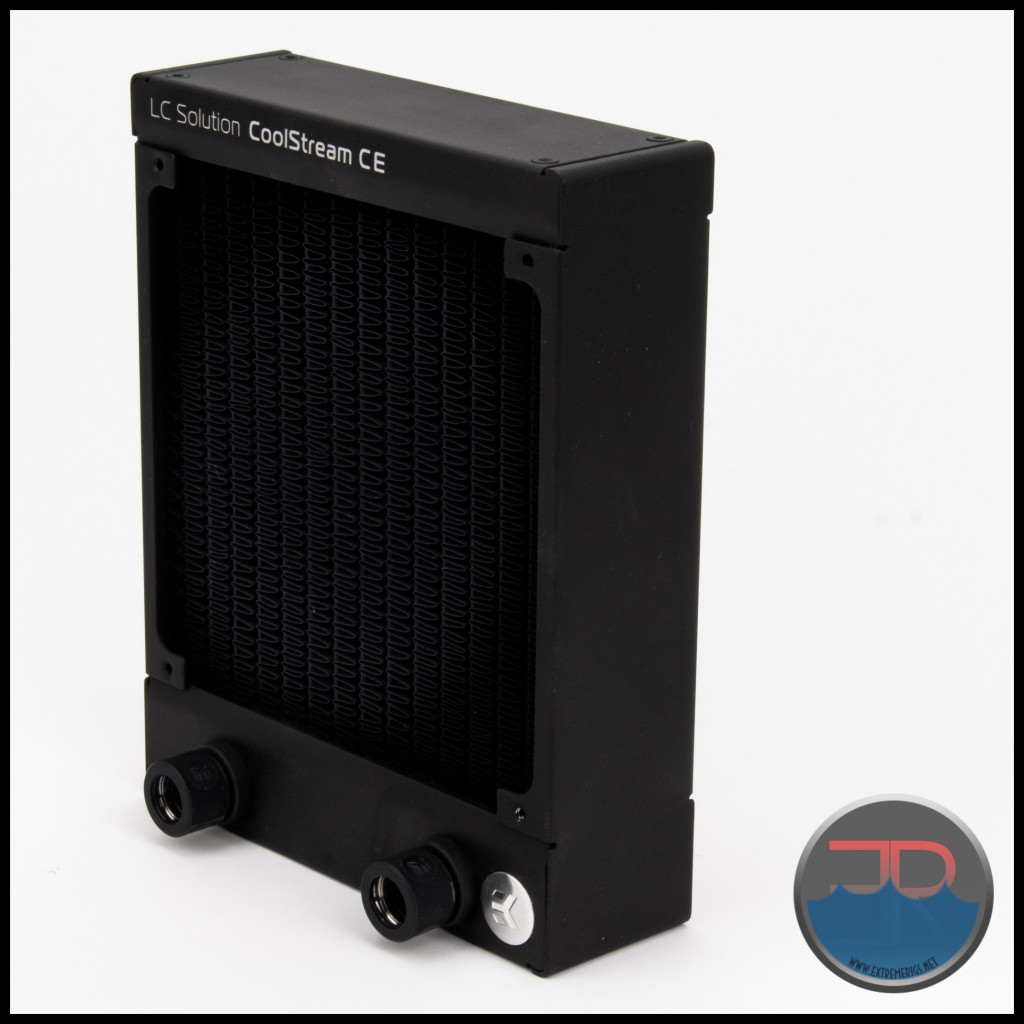
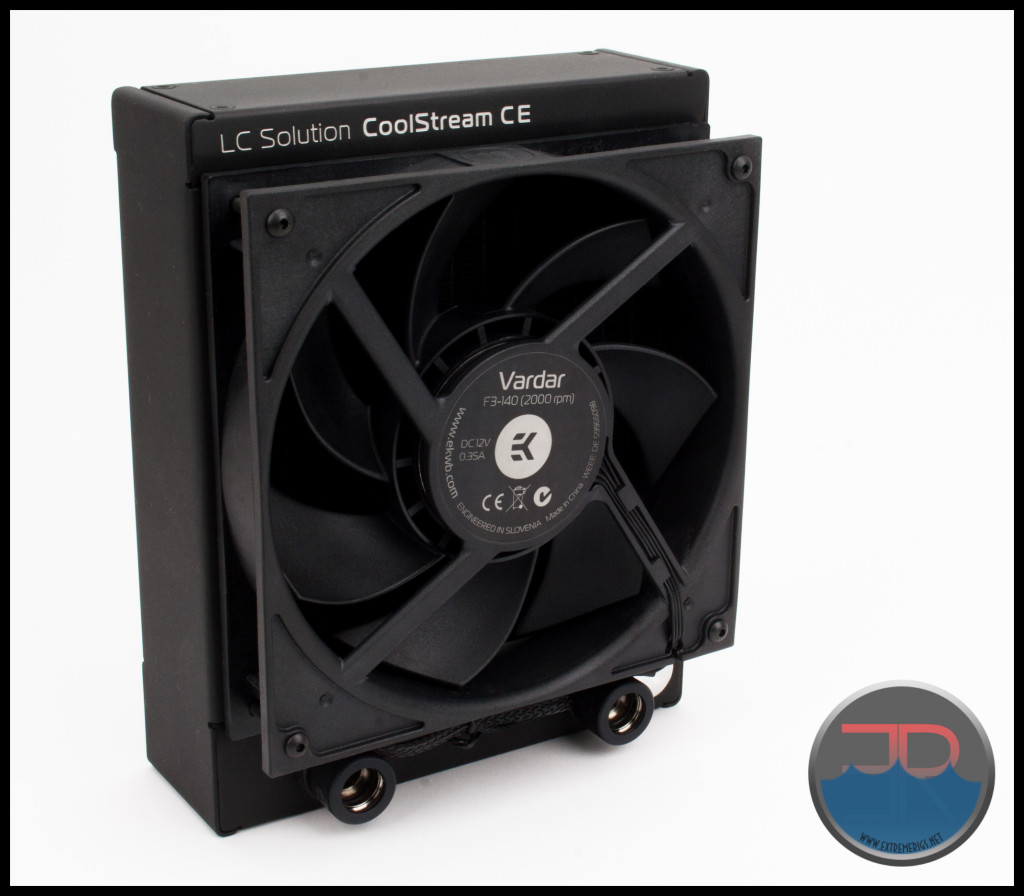
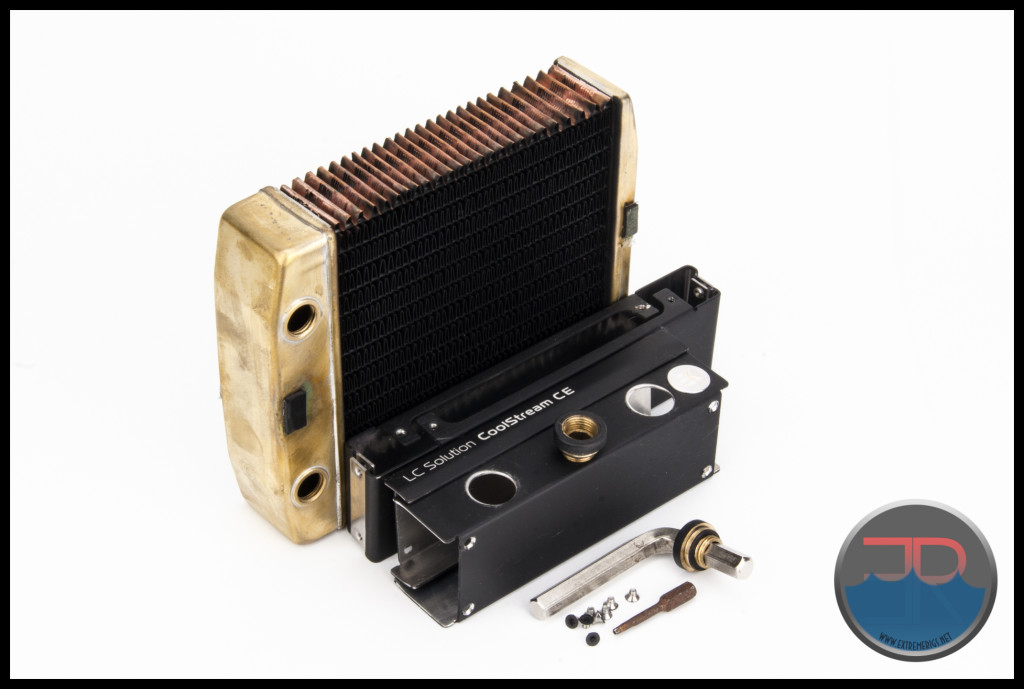
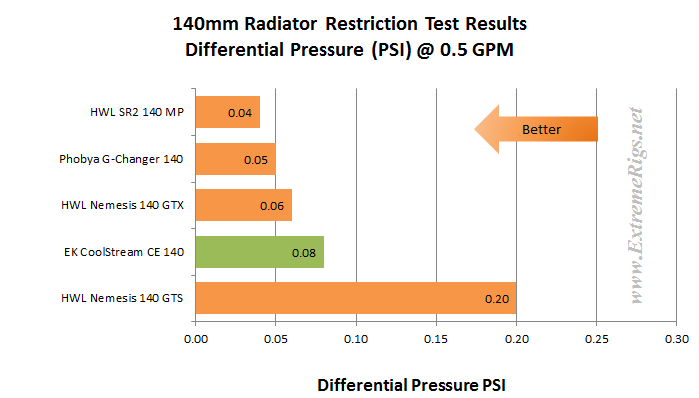
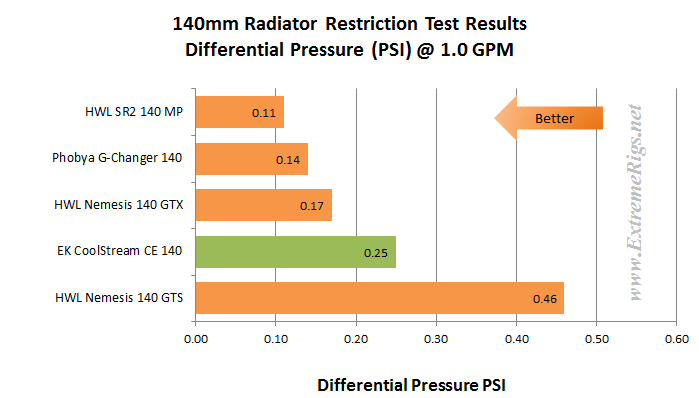
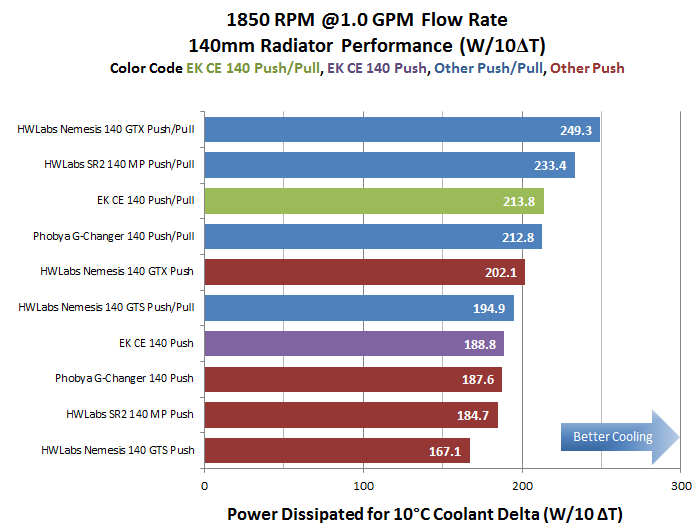
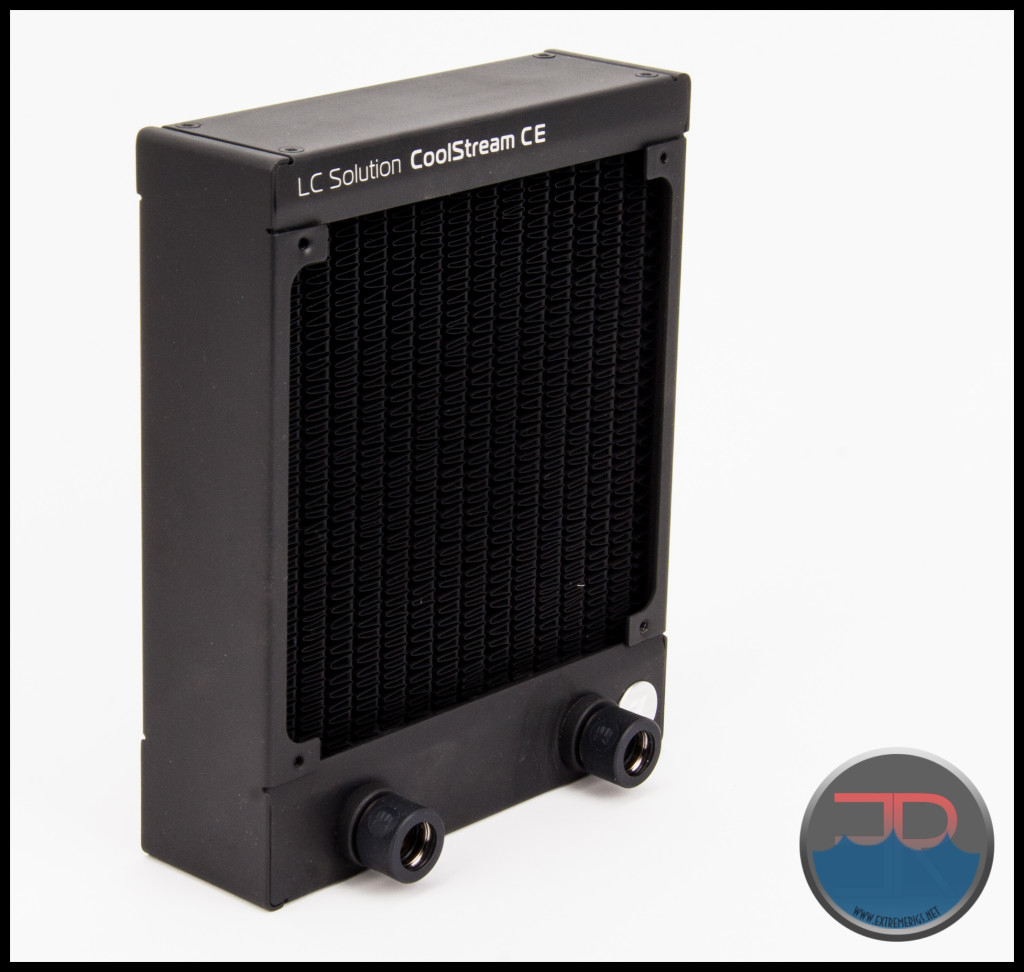


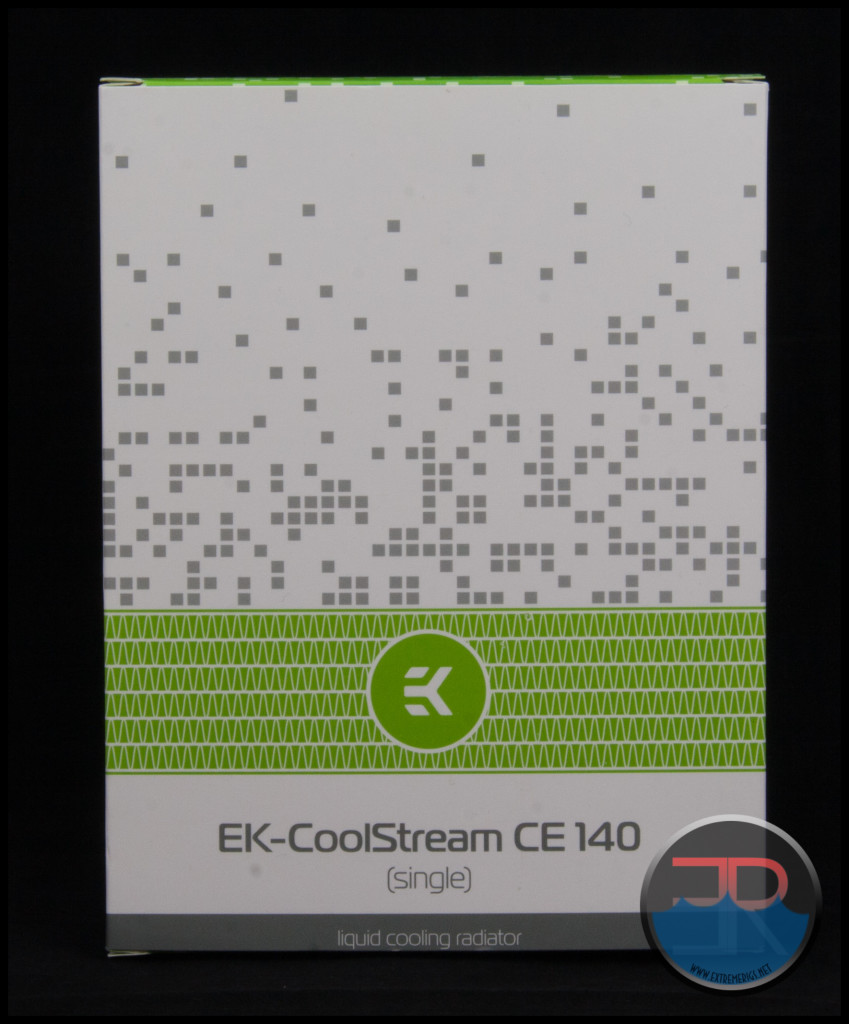



[…] EK CE 140 Radiator Hardware Labs Nemesis GTS 140 Radiator Hardware Labs Nemesis GTX 140 Radiator Hardware Labs SR2 140 Radiator Phobya G-Changer 140 Radiator […]
Comments are closed.